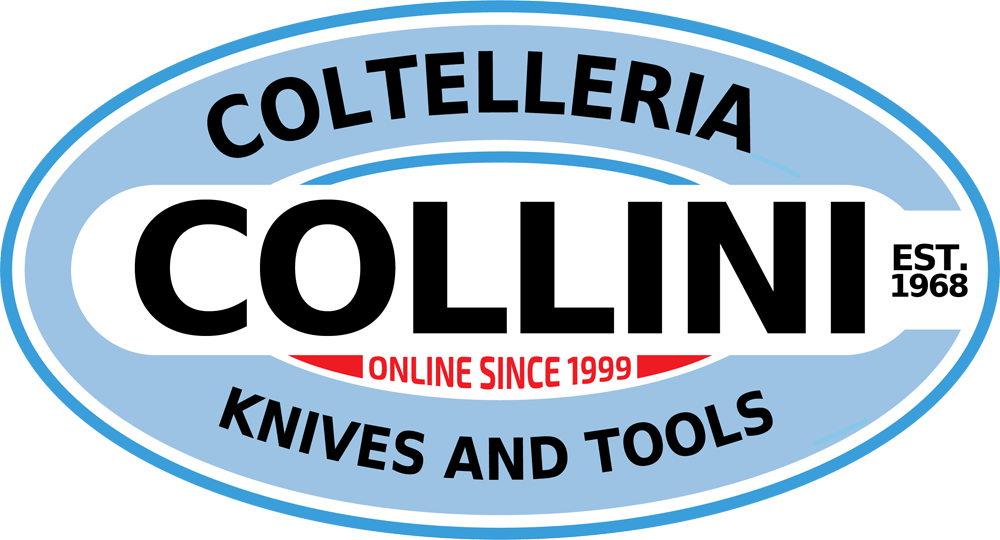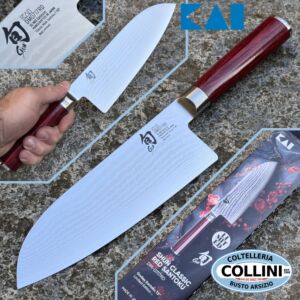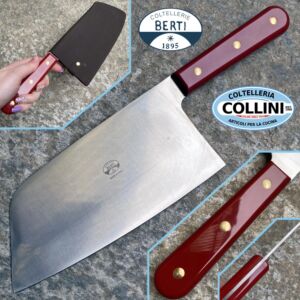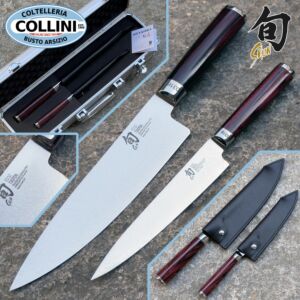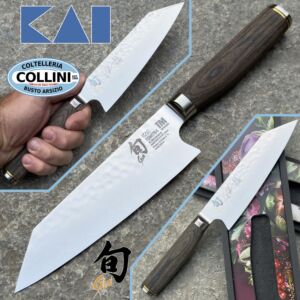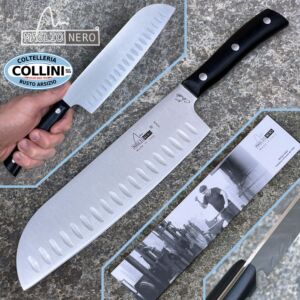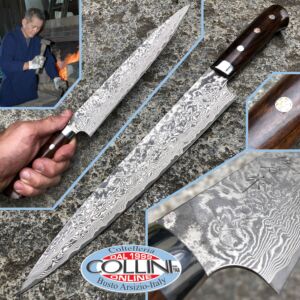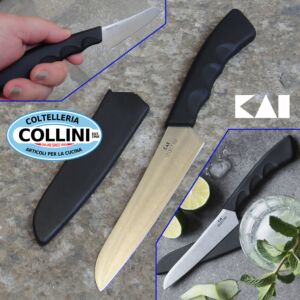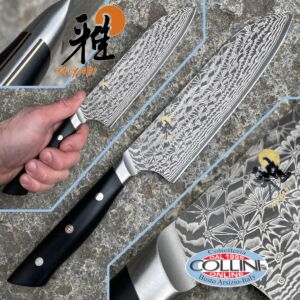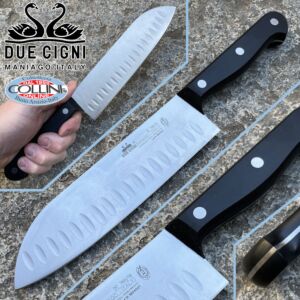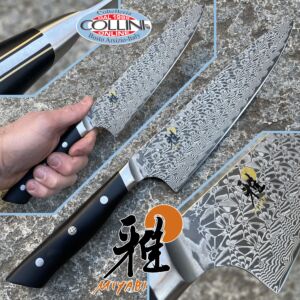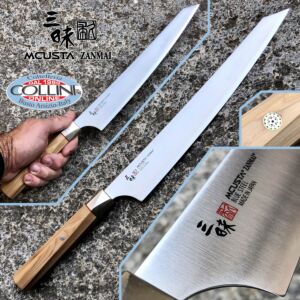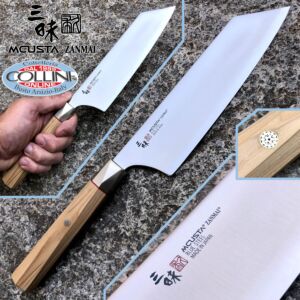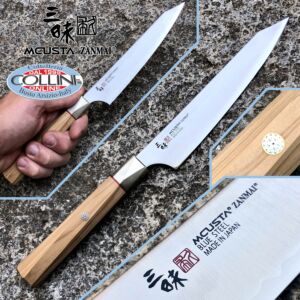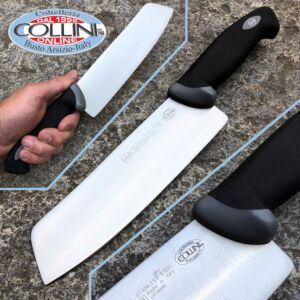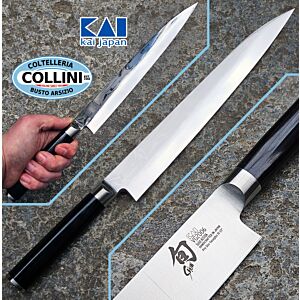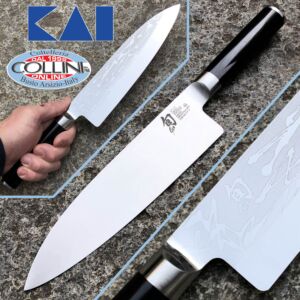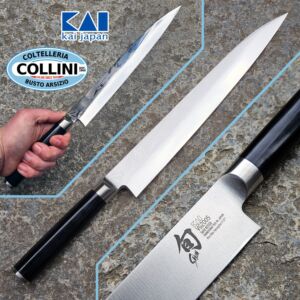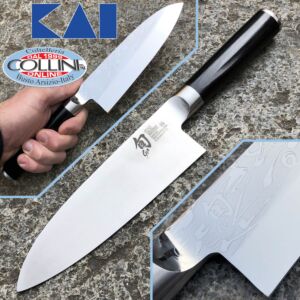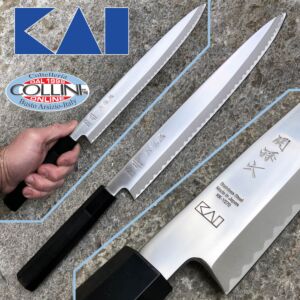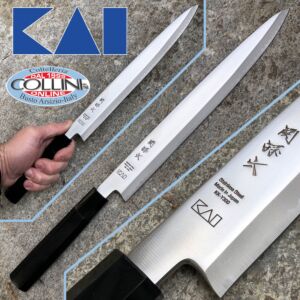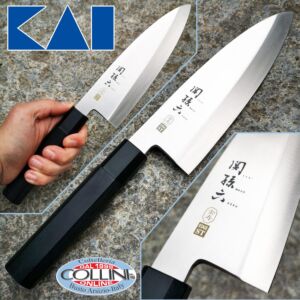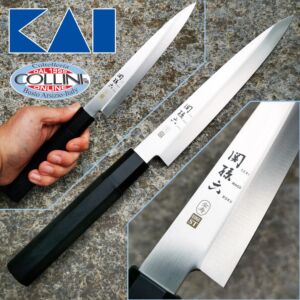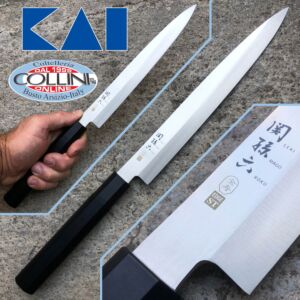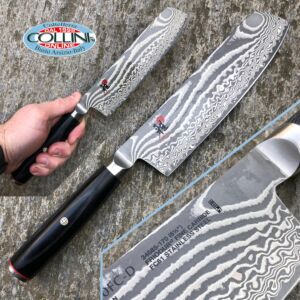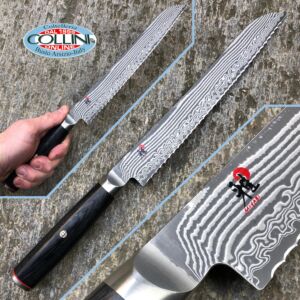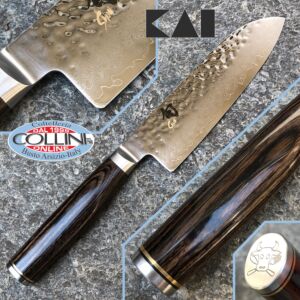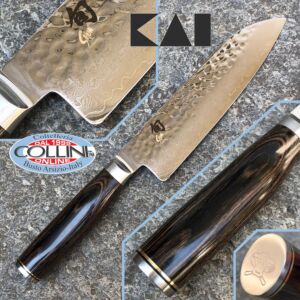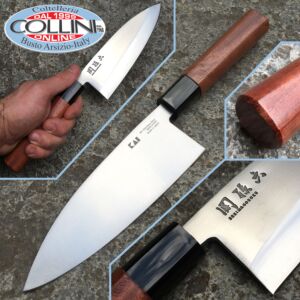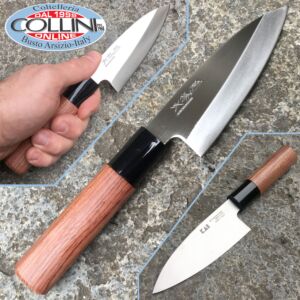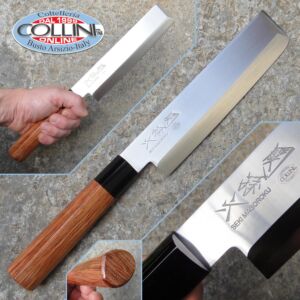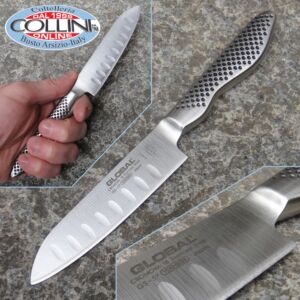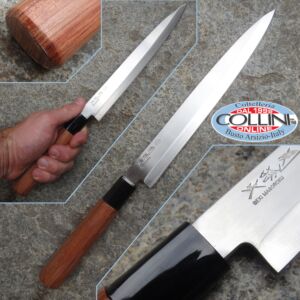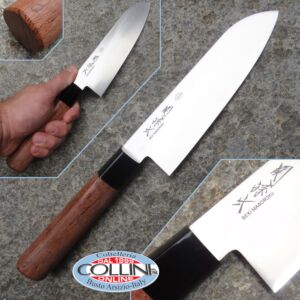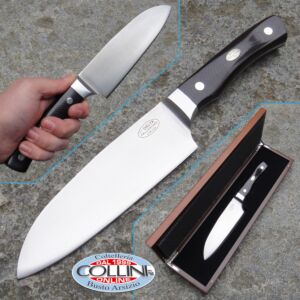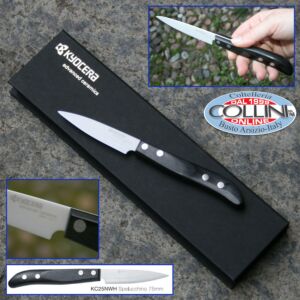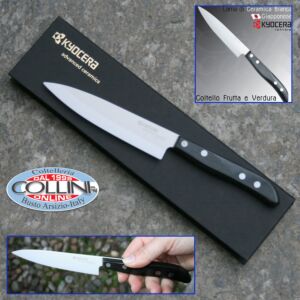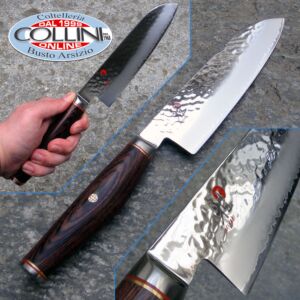Japanese Kitchen Knives: Essential Characteristics and Types for Every Chef
-
Kai Japan - Shun DM-0717RD - Wide Santoku Knife 190mm - Red Limited Edition - kitchen knives
KAI presents the new Shun Classic Red DM-0717RD as a highlight. The exclusive Wide Santoku combines the proven qualities of the Shun Classic series with a new and elegant red grain pakkawood handle in a limited edition. The knife is limited to only 3,000 pieces worldwide. The serial number engraved on the bolster makes each knife unique and desirable as a collector's item.
The extremely sharp blade is made of an extremely hard VG-MAX steel core with a hardness of 61 (±1) HRC and is coated with 32 layers of Damascus steel. This combination ensures an extremely stable, hard, and yet flexible blade, ideal for a clean and precise cut. The blade is ground on both sides and is particularly lightweight, making it easier to use in the kitchen.
As with the regular knives of the Shun Classic series, the special red grain handle of the Shun Classic Red is made of pakkawood. The treatment with selected resins makes it extremely soft, elastic, durable, and moisture-resistant. Thanks to the traditional Japanese "chestnut" shape of the handle, the Wide Santoku fits comfortably in the hand during cutting and offers a firm grip.
Recommended use: cutting and preparing vegetables - trimming and initial processing of fish
Country of Manufacture: Japan
Blade: 32-layer Damascus laminate and VG-10 stainless steel
Handle: Pakkawood
Blade length: 190mm.
Blade thickness: 2mm.
Total length: 325mm.
Weight: 238g.
Maintenance: hand wash only / NOT dishwasher safe
Notes: Limited edition and numbered with only 3,000 pieces worldwideDM-0717RD -
Berti - THE ONE - Oriental Tou with scabbard - 18cm
The "The One" knife from the I Cucinieri Collection is a versatile oriental tou designed for a variety of kitchen preparations.
Ideal for dicing or julienne vegetables and chopping herbs, it proves equally practical for slicing meat and fish.
Thanks to its size, it is both effective and handy, offering optimal balance during use.
The smooth 18-cm blade, made of recycled steel, allows precise and even cuts, preserving the flavor and appearance of foods.
This Asian-inspired knife becomes an indispensable tool for budding chefs and cooking enthusiasts.
Its versatility is expressed in its ability to cut vegetables in various formats, chop herbs, and slice meat and fish, raw or cooked.
Thanks to its wide, flat blade, it can also be used as a countertop scraper to scoop up cut foods, making it easier to transfer to a bowl or when cooking.
With its precise cut and practicality of use, "The One" proves to be a valuable ally in the kitchen for all kinds of preparations.Blade length: 18cm
Weight: 336g
Line: i cucinieri
1104000 -
Kai Japan - Seki Magoroku Kaname - AE-5502 - Kiritsuke 19.5cm. - professional kitchen knife
The core of Kaname blades is made of an extremely durable VGXeos steel with a hardness of 60-62 (±1) HRC, rolled in two layers of stainless steel. The special manufacturing method ensures an incredibly thin cutting edge that reduces friction during use. This results in excellent and durable sharpness, promoting filigree, smooth and precise cuts.
To best design the handle, we combined the experiences of professionals and consumers. The result is a black-grained pakkawood handle that creates a seamless transition from the handle to the tang. The octagonal, ergonomic shape of the handle provides good control while cutting, while the knife rests securely and comfortably in the hand.
Blade: VGXeos rolled stainless steel with a hardness of 60/62±1 HRC
Country of manufacture: Japan
Handle: pakkawood
Blade length: 195mm.
Handle length: 130mm.
Blade thickness: 1.5mm.
Total length: 325mm.
Weight: 160g.
Care and maintenance: hand wash only - keep sharp with a fine-grained sharpening steel or sharpening stone of at least grit #3000AE-5502 -
Kai Japan - Seki Magoroku Kaname - AE-5501 - Kiritsuke 15cm. - professional kitchen knife
The core of Kaname blades is made of an extremely durable VGXeos steel with a hardness of 60-62 (±1) HRC, rolled in two layers of stainless steel. The special manufacturing method ensures an incredibly thin cutting edge that reduces friction during use. This results in excellent and durable sharpness, promoting filigree, smooth and precise cuts.
To best design the handle, we combined the experiences of professionals and consumers. The result is a black-grained pakkawood handle that creates a seamless transition from the handle to the tang. The octagonal, ergonomic shape of the handle provides good control while cutting, while the knife rests securely and comfortably in the hand.
Blade: VGXeos rolled stainless steel with a hardness of 60/62±1 HRC
Country of manufacture: Japan
Handle: pakkawood
Blade length: 150mm.
Handle length: 130mm.
Blade thickness: 1.5mm.
Total length: 280mm.
Weight: 134g.
Care and maintenance: wash by hand only - keep sharp with a fine-grained sharpening steel or a sharpening stone of at least grit #3000AE-5501 -
Kai Japan - Seki Magoroku Kaname - AE-5500 - Kiritsuke 12cm. - professional kitchen knife
The core of Kaname blades is made of an extremely durable VGXeos steel with a hardness of 60-62 (±1) HRC, rolled in two layers of stainless steel. The special manufacturing method ensures an incredibly thin cutting edge that reduces friction during use. This results in excellent and durable sharpness, promoting filigree, smooth and precise cuts.
To best design the handle, we combined the experiences of professionals and consumers. The result is a black-grained pakkawood handle that creates a seamless transition from the handle to the tang. The octagonal, ergonomic shape of the handle provides good control while cutting, while the knife rests securely and comfortably in the hand.
Blade: VGXeos rolled stainless steel with a hardness of 60/62±1 HRC
Country of Manufacture: Japan
Handle: pakkawood
Blade length: 120mm.
Handle Length: 130mm.
Blade thickness: 1.5mm.
Total length: 250mm.
Weight: 78g.
Care: wash by hand only
Maintenance: keep sharp with a fine-grained sharpening steel or a sharpening stone of at least grit #3000AE-5500 -
Kai Japan - Shun Kohen Anniversary - TBS-0220 - Limited Edition Luxury Set - kitchen knives
With the two Kohen knives, the Japanese company once again demonstrates its great expertise in producing high-quality kitchen knives. The "Coreless" Damascus blade is made from VG2 and VG10 high-performance stainless steels that are forged and folded to produce 72 layers that alternate sequentially on the edge of the blade to ensure unmatched cutting and edge-holding performance.
A premium material such as pakkawood in red and black colorations was chosen for the handles. Also included in the set are two leather blade protector sheaths and an aluminum case for storing and transporting these two valuable knives safely.
Blade: Japanese Coreless rolled stainless steel - 72 alternating layers of VG10 and VG2 at 60±2 HRC
Handle: Pakkawood
Kitchen knife blade length: 200mm.
Petty/utility knife blade length: 150mm.
Sheaths: leather, for use as blade covers
Packaging: aluminum case with warranty certificates
Edition: numbered and limited to 3000 pieces worldwide
Maintenance: hand wash only, do not wash in dishwasherTBS-0220 -
Coltelleria Collini - Renkei Series - Santoku 18 cm - VG10 with 67 layers - SanMai steel - CO760/18 - kitchen knives
The Santoku is a knife that needs no introduction. A real joker in the kitchen, especially when working with vegetables. Nimble and light, it glides across the cutting board, chopping and mincing with precision. When form is combined with the substance of first-class materials, the result can only be of the highest standard.
Blade: SanMai VG10 Damascus stainless steel with 67 layers
Handle: Blue Micarta
Blade length: 180 mm.
Handle length: 130 mm.
Blade thickness: 2.2 mm.
Total length: 300 mm.
Weight: 194 g.
Note: Do not wash in the dishwasher.Packaging: Elegant black cardboard box with technical information and product history - the package includes a polymer blade guard to protect the knife.
Renkei (連携) is a Japanese term that means collaboration, coordination, or connection. It is used to express the idea of working together, in close cooperation, to achieve a common goal or to create synergies between different people or organizations.
This project, born from the collaboration between Coltelleria Collini in Busto Arsizio and Coltelleria Due Cigni in Maniago, is an excellent example of synergy between two Italian companies specializing in the world of cutlery.
The Japanese VG10 steel used in this project, laminated to 67 layers and produced by Takefu Steel, is renowned for its extraordinary properties of strength, durability, and the ability to maintain a prolonged sharpness over time. These characteristics make the steel ideal for the production of high-quality knives.
The 67-layer lamination technique gives the steel superior strength and flexibility compared to traditional steels. Additionally, the use of this Japanese steel gives the knives a distinctive and elegant design, with a particular wave pattern on the surface of the blade that forms during the manufacturing process.
The collaboration between Coltelleria Collini and Coltelleria Due Cigni highlights how the combination of skills and traditions of two Italian entities can lead to the creation of high-quality products, capable of competing with the best kitchen knives on the international market.
Thanks to the use of precious materials and attention to detail, these knives combine the excellence of Made in Italy with the high quality of the Japanese tradition in the cutlery sector.
CO-760-18 -
Kai Japan - Shun Premier Tim Mälzer TDM-1784 - Small Kiritsuke 15cm - 13 The Lucky Edition - kitchen knives
Kai Europe offers another exclusive collaboration with master-chef Tim Mälzer: Small Kiritsuke 13 The Lucky Edition.
A special edition with an opaque brown handle and a 15 cm hammered blade. The edition is limited to only 5555 pieces and each one is numbered. As such, each knife is a unique collector's item.
As with the previous limited edition, the Kiritsuke was chosen, but in a smaller size. This is a type of Japanese knife that combines the design and characteristics of a usuba and a yanagiba. The usuba is used for cutting vegetables and the yanagiba for raw fish, for example when making sashimi. As such, the kiritsuke can be used for many different tasks in the kitchen: cutting vegetables, meat and fish. The tanto inverted profile makes the tip very flexible and perfect for precision tasks. The flat blade is perfect for other cutting tasks.
The superbly sharp blade is made of VG MAX steel with a hardness of 61 (± 1) HRC and surrounded by 32-layer Damascus steel. The Damascus steel makes each knife unique. The matt handle of this special edition is, like the regular knives in the Tim Mälzer Premier collection, made of walnut wood: it is moisture-resistant thanks to the resin treatment. The chestnut shape of the handle is comfortable in the hand and provides a firm grip when using the knife.
Blade: Damascus stainless steel VG MAX hardness of 61±1 HRC
Handle: Matt walnut wood
Blade length: 155 mm.
Handle length: 120 mm.
Blade thickness: 1.9 mm.
Total length: 285 mm.
Weight: 151 g.
Notes: not dishwasher safe - wooden presentation boxTDM-1784 -
MaglioNero - Iside Line - Maxi Santoku 21cm - IS5521 - kitchen knife
Fratelli Rizzi was founded at the end of the 19th century in Premana, a small Italian mountain village located between Valtellina and Valsassina. A flexible and competitive company that, combining the typical characteristics of craftsmanship with the continuous research of new technologies, is synonymous with quality in the production of professional cutlery.
In 2012, after about 50 years of experience in the cutlery sector, Fratelli Rizzi decides to propose its own lines of professional cutlery under the name of MaglioNero, combining them with numerous collaborations with the best Italian and European operators in the field of professional cutlery.
THE ISIDE LINE
Developed with the help of Michelin-starred chef Iside De Cesare, it was created to best satisfy all cutting needs in the kitchen.
It features modern, elegant and functional lines, with a full silk handle and Nitro-B steel blades with a hardness of 57HRC to ensure a high level of edge retention and marked corrosion resistance. The handles, full tang, are made of polished POM with stainless steel rivets; their special design is studied to offer a comfortable ergonomics and optimize the balance of the knife.
Suggested use: vegetables, raw meat, fishCountry of production: Premana, Italy
Cutting edge: Nitro-B stainless steel with a hardness of 57HRC
Blade finish: satin
Blade length: 170mm.
Construction: full tang with riveted handle
Handle: black POM
Maintenance: manual washing recommended; suitable for occasional washing in the dishwasherMN-IS5521 -
MaglioNero - Iside line - Santoku 17cm - IS5517 - kitchen knife
Fratelli Rizzi was founded at the end of the 19th century in Premana, a small Italian mountain village located between Valtellina and Valsassina. A flexible and competitive company that, combining the typical characteristics of craftsmanship with the continuous research of new technologies, is synonymous with quality in the production of professional cutlery.
In 2012, after about 50 years of experience in the cutlery sector, Fratelli Rizzi decides to propose its own lines of professional cutlery under the name of MaglioNero, combining them with numerous collaborations with the best Italian and European operators in the field of professional cutlery.
THE ISIDE LINE
Developed with the help of Michelin-starred chef Iside De Cesare, it was created to best satisfy all cutting needs in the kitchen.
It features modern, elegant and functional lines, with a full silk handle and Nitro-B steel blades with a hardness of 57HRC to ensure a high level of edge retention and marked corrosion resistance. The handles, full tang, are made of polished POM with stainless steel rivets; their special design is studied to offer a comfortable ergonomics and optimize the balance of the knife.
Suggested use: vegetables, raw meat, fishCountry of production: Premana, Italy
Cutting edge steel: Nitro-B stainless steel with hardness of 57HRC
Blade finish: satin
Blade length: 170mm.
Construction: full tang with riveted handle
Handle: black POM
Maintenance: manual washing recommended; suitable for occasional washing in the dishwasherMN-IS5517 -
MaglioNero - Iside Line - Santoku 19cm - IS5519 - kitchen knife
Fratelli Rizzi was founded at the end of the 19th century in Premana, a small Italian mountain village located between Valtellina and Valsassina. A flexible and competitive company that, combining the typical characteristics of craftsmanship with the continuous research of new technologies, is synonymous with quality in the production of professional cutlery.
In 2012, after about 50 years of experience in the cutlery sector, Fratelli Rizzi decides to propose its own lines of professional cutlery under the name of MaglioNero, combining them with numerous collaborations with the best Italian and European operators in the field of professional cutlery.
THE ISIDE LINE
Developed with the help of Michelin-starred chef Iside De Cesare, it was created to best satisfy all cutting needs in the kitchen.
It features modern, elegant and functional lines, with a full silk handle and Nitro-B steel blades with a hardness of 57HRC to ensure a high level of edge retention and marked corrosion resistance. The handles, full tang, are made of polished POM with stainless steel rivets; their special design is studied to offer a comfortable ergonomics and optimize the balance of the knife.
Suggested use: vegetables, raw meat, fishCountry of production: Premana, Italy
Cutting edge steel: Nitro-B stainless steel with hardness of 57HRC
Blade finish: satin
Blade length: 190mm.
Construction: full tang with riveted handle
Handle: black POM
Maintenance: manual washing recommended; suitable for occasional washing in the dishwasherMN-IS5519 -
Takeshi Saji - Bunka Knife 180mm in deer horn - VG-10 32 layers - vegetable kitchen knife
Takeshi Saji was born in 1948 in Takefu (Fukui prefecture), a city located roughly in the center of Japan and in the heart of an area for centuries devoted to the production of blades. His workshop is still there, built around the oven thanks to which, for several years now, Takeshi Saji has been forging steel (especially damascus) with which he makes various models of traditional Japanese knives. The choice of materials for the finishes (mainly natural), the essential lines - evocative of use - and the chromatic combinations of rare impact make his creations unique and unmistakable in the panorama of world cutlery and, at home, they have earned him the prestigious title of Maestro.
Intended use: vegetable knife
Type of production: Artisan
Production Lama: Japan
Blade: Hand forged, laminated damascus with 32-layer VG10 steel edge
Handle: in deer horn
Blade length: 180mm.
Blade thickness: 2.5mm.
Total length: 305mm.
Weight: 236g.
Packaging: Cardboard box
Notes: the knife is entirely handmade by Takeshi SajUse and maintenance
- Do not cut bones or frozen. The blade can chip or break.
- Hand wash with warm water and towel dry.
- Use stones for sharpening and maintenance of the blade.TS-BUN-H -
Takeshi Saji - Nakiri Knife 170mm in corno di cervo - VG-10 a 32 strati - coltello cucina verdure
Takeshi Saji was born in 1948 in Takefu (Fukui prefecture), a city located roughly in the center of Japan and in the heart of an area for centuries devoted to the production of blades. His workshop is still there, built around the oven thanks to which, for several years now, Takeshi Saji has been forging steel (especially damascus) with which he makes various models of traditional Japanese knives. The choice of materials for the finishes (mainly natural), the essential lines - evocative of use - and the chromatic combinations of rare impact make his creations unique and unmistakable in the panorama of world cutlery and, at home, they have earned him the prestigious title of Maestro.
Intended use: vegetable knife
Type of production: Artisan
Production Lama: Japan
Blade: Hand forged, laminated damascus with 32-layer VG10 steel edge
Handle: in deer horn
Blade length: 170mm.
Blade thickness: 2.5mm.
Total length: 300mm.
Weight: 260g.
Packaging: Cardboard box
Notes: the knife is entirely handmade by Takeshi SajUse and maintenance
- Do not cut bones or frozen. The blade can chip or break.
- Hand wash with warm water and towel dry.
- Use stones for sharpening and maintenance of the blade.TS-NAK-H -
Takeshi Saji - Sujihiki Knife 240mm with Desert Ironwood Handle - SPG2 Damascus - kitchen knife
Takeshi Saji was born in 1948 in Takefu (Fukui prefecture), a city located roughly in the center of Japan and in the heart of an area for centuries devoted to the production of blades. His workshop is still there, built around the oven thanks to which, for several years now, Takeshi Saji has been forging steel (especially damascus) with which he makes various models of traditional Japanese knives. The choice of materials for the finishes (mainly natural), the essential lines - evocative of use - and the chromatic combinations of rare impact make his creations unique and unmistakable in the panorama of world cutlery and, at home, they have earned him the prestigious title of Maestro.
Intended use: kitchen knife, meat, fish
Type of production: Artisan
Production Lama: Japan
Blade: Hand forged, laminated damascus with SPG2 sintered steel edge (63 hrc)
Handle: Desert Ironwood
Blade length: 235mm.
Blade thickness: 2.5mm.
Total length: 365mm.
Weight: 200g.
Packaging: Wooden box
Notes: the knife is entirely handmade by Takeshi SajUse and maintenance
- Do not cut bones or frozen. The blade can chip or break.
- Hand wash with warm water and towel dry.
- Use stones for sharpening and maintenance of the bladeTS-SUJ -
Kai Japan - Fruit Knife
Select 100 Kitchen tools
The Select 100 cooking utensils form a series of useful kitchen utensils for daily use. The Series focuses on stylish and simple equipment for easy use and clever functionality. The high quality range is an ideal addition for a range of tasks in a demanding kitchen environment.
Fruit knife with plastic knife sheath |
DH-3014 Blade 12,0 cm,
Handle 11,0 cm
DH-3014 -
Kai Japan - Fruit Knife
Kai Japan - Fruit Knife
The Kai Fruit Knife from the Select series has a stainless blade and is a handy tool in the kitchen or on the way at the picnic.
The Kai Fruit Knife is always safely stored by the scabbard made of cherry wood.
The elegant, simple and ergonomic design of the Kai fruit knife is convincing.
The Kai fruit knife is not dishwasher safe and should always be cleaded by hand.
DG-3002, length/dimension: 9.50 cm
DG-3002 -
Zwilling - Miyabi Hibana 800DP - Santoku 180mm. 54487-181 - kitchen knife
Recommended use: Vegetables
Country of production: Japan
Blade structure: sanmai with 49-layer external damask
Cutting steel: stainless steel, Sandvik FC61
Type of sharpening: Honbazuke, symmetrical
Blade finish: Passive etching
Blade length: 180mm.
Construction: Forged
Handle: in Nylon, triple rivet, with brass spacers
Maintenance: hand wash only54487-181 -
Due Cigni - Classic Line 2C - Santoku knife 18cm - 760/18 - kitchen knife
In the ancient City of Cutlery in Maniago, DUE CIGNI has been passionately producing high quality professional scissors and knives for over a century.
Special steels of the highest quality, innovative design and attention to the smallest details ensure that DUE CIGNI products do not go indifferent even to the most demanding user.
Latest generation machinery, qualified personnel and renovation are the elements on which the solid basis of the success of the DUE CIGNI brand is founded.
DUE CIGNI knives and scissors are ideal tools for professional users in the food and gastronomy sectors who need a perfect cut, effortlessly that lasts over time ... for over a hundred years.Recommended use: vegetable, meat, fish knife
Country of production: Italy
Cutting steel: stainless steel 4116 X50CrMoV15 - HRC 55-57
Blade finish: satin
Blade length: 180mm.
Construction: full tang
Handle: black POM
Maintenance: also dishwasher safeDC-760/18 -
Zwilling - Miyabi Hibana 800DP - Gyutoh 200mm. 54481-201 - kitchen knife
Recommended use: vegetables
Country of production: Japan
Blade structure: sanmai with 49-layer external damask
Cutting steel: stainless steel, Sandvik FC61
Type of sharpening: Honbazuke, symmetrical
Blade finish: Passive etching
Blade length: 210mm.
Construction: Forged
Handle: in Nylon, triple rivet, with brass spacers
Maintenance: hand wash only54481-201 -
Mcusta Zanmai - Beyond Sujihiki slicing knife 27cm - Aogami Super steel - ZBX-5011B - kitchen knife
The BEYOND series is the line of top-of-the-range professional knives produced by the Japanese MCUSTA ZANMAI for the year 2020.
The handles of the Beyond series are made of Hinoki wood and as per tradition have a decorative rivet with mosaic. The three-layer blade, with the two external stainless steel and the internal core in Aogami Super carbon (Super Blue Steel) is hardened to 62-63 HRC. Each knife is packaged in a wooden gift box with a bow.
Production: Semi-artisanal
Blade: 3-layer steel - stainless steel extrene plates, Aogami Super core (Super Blue carbon steel) 62-63 HRC
Handle: Hinoki wood
Blade length: 270 mm.
Blade thickness: 2 mm.
Total length: 432 mm
Weight: 180g.
Notes: not dishwasher safe
Packaging: elegant wooden boxSteel specifications:
Aogami Super (Hitachi Metals Ltd.) is one of the best Japanese carbon. In addition to containing more carbon, chromium and tungsten than Blue Steel, it also includes molybdenum. It has excellent cutting ability and excellent thread retention. Aogami Super is also capable of achieving high hardness without being brittle. Many knife enthusiasts consider Aogami Super to be one of the best high carbon steels in the world.
The city of Seki in Japan has been the center of producing the best Japanese blades since the mid-13th century. Natural choice thanks to its wealth of natural resources: sand, iron, coal and water, all important elements for the processing of blades. The techniques and skills of the ancient blacksmiths, handed down over the centuries, have currently been combined with modern technologies. The city of Seki still remains today the center of production of the best Japanese blades.
Mcusta knives are made in Seki and are the pinnacle of this synthesis between Japanese artisan tradition and modern technology. Each knife is assembled by hand, finished and checked by the craftsmen of the Mcusta team. Mcusta knives are considered among the best in the world!
Coltelleria Collini is the official distributor for Italy of MCUSTA Japanese knives
ZBX-5011B -
Mcusta Zanmai - Beyond Nakiri vegetable knife 16,5cm - Aogami Super steel - ZBX-5008B - kitchen knife
The BEYOND series is the line of top-of-the-range professional knives produced by the Japanese MCUSTA ZANMAI for the year 2020.
The handles of the Beyond series are made of Hinoki wood and as per tradition have a decorative rivet with mosaic. The three-layer blade, with the two external stainless steel and the internal core in Aogami Super carbon (Super Blue Steel) is hardened to 62-63 HRC. Each knife is packaged in a wooden gift box with a bow.
Production: Semi-artisanal
Blade: 3-layer steel - stainless steel extrene plates, Aogami Super core (Super Blue carbon steel) 62-63 HRC
Handle: Hinoki wood
Blade length: 165 mm.
Blade thickness: 2 mm.
Total length: 315 mm
Weight: 170g.
Notes: not dishwasher safe
Packaging: elegant wooden boxSteel specifications:
Aogami Super (Hitachi Metals Ltd.) is one of the best Japanese carbon. In addition to containing more carbon, chromium and tungsten than Blue Steel, it also includes molybdenum. It has excellent cutting ability and excellent thread retention. Aogami Super is also capable of achieving high hardness without being brittle. Many knife enthusiasts consider Aogami Super to be one of the best high carbon steels in the world.
The city of Seki in Japan has been the center of producing the best Japanese blades since the mid-13th century. Natural choice thanks to its wealth of natural resources: sand, iron, coal and water, all important elements for the processing of blades. The techniques and skills of the ancient blacksmiths, handed down over the centuries, have currently been combined with modern technologies. The city of Seki still remains today the center of production of the best Japanese blades.
Mcusta knives are made in Seki and are the pinnacle of this synthesis between Japanese artisan tradition and modern technology. Each knife is assembled by hand, finished and checked by the craftsmen of the Mcusta team. Mcusta knives are considered among the best in the world!
Coltelleria Collini is the official distributor for Italy of MCUSTA Japanese knives
ZBX-5008B -
Mcusta Zanmai - Beyond Bunka knife 18cm - Aogami Super steel - ZBX-5016B - kitchen knife
The BEYOND series is the line of top-of-the-range professional knives produced by the Japanese MCUSTA ZANMAI for the year 2020.
The handles of the Beyond series are made of Hinoki wood and as per tradition have a decorative rivet with mosaic. The three-layer blade, with the two external stainless steel and the internal core in Aogami Super carbon (Super Blue Steel) is hardened to 62-63 HRC. Each knife is packaged in a wooden gift box with a bow.
Production: Semi-artisanal
Blade: 3-layer steel - stainless steel extrene plates, Aogami Super core (Super Blue carbon steel) 62-63 HRC
Handle: Hinoki wood
Blade length: 180 mm.
Blade thickness: 2 mm.
Total length: 335 mm
Weight: 147g.
Notes: not dishwasher safe
Packaging: elegant wooden boxSteel specifications:
Aogami Super (Hitachi Metals Ltd.) is one of the best Japanese carbon. In addition to containing more carbon, chromium and tungsten than Blue Steel, it also includes molybdenum. It has excellent cutting ability and excellent thread retention. Aogami Super is also capable of achieving high hardness without being brittle. Many knife enthusiasts consider Aogami Super to be one of the best high carbon steels in the world.
The city of Seki in Japan has been the center of producing the best Japanese blades since the mid-13th century. Natural choice thanks to its wealth of natural resources: sand, iron, coal and water, all important elements for the processing of blades. The techniques and skills of the ancient blacksmiths, handed down over the centuries, have currently been combined with modern technologies. The city of Seki still remains today the center of production of the best Japanese blades.
Mcusta knives are made in Seki and are the pinnacle of this synthesis between Japanese artisan tradition and modern technology. Each knife is assembled by hand, finished and checked by the craftsmen of the Mcusta team. Mcusta knives are considered among the best in the world!
Coltelleria Collini is the official distributor for Italy of MCUSTA Japanese knives
ZBX-5016B -
Mcusta Zanmai - Beyond Santoku knife 18cm - Aogami Super steel - ZBX-5003B - kitchen knife
The BEYOND series is the line of top-of-the-range professional knives produced by the Japanese MCUSTA ZANMAI for the year 2020.
The handles of the Beyond series are made of Hinoki wood and as per tradition have a decorative rivet with mosaic. The three-layer blade, with the two external stainless steel and the internal core in Aogami Super carbon (Super Blue Steel) is hardened to 62-63 HRC. Each knife is packaged in a wooden gift box with a bow.
Production: Semi-artisanal
Blade: 3-layer steel - stainless steel extrene plates, Aogami Super core (Super Blue carbon steel) 62-63 HRC
Handle: Hinoki wood
Blade length: 180 mm.
Blade thickness: 2 mm.
Total length: 335 mm
Weight: 147g.
Notes: not dishwasher safe
Packaging: elegant wooden boxSteel specifications:
Aogami Super (Hitachi Metals Ltd.) is one of the best Japanese carbon. In addition to containing more carbon, chromium and tungsten than Blue Steel, it also includes molybdenum. It has excellent cutting ability and excellent thread retention. Aogami Super is also capable of achieving high hardness without being brittle. Many knife enthusiasts consider Aogami Super to be one of the best high carbon steels in the world.
The city of Seki in Japan has been the center of producing the best Japanese blades since the mid-13th century. Natural choice thanks to its wealth of natural resources: sand, iron, coal and water, all important elements for the processing of blades. The techniques and skills of the ancient blacksmiths, handed down over the centuries, have currently been combined with modern technologies. The city of Seki still remains today the center of production of the best Japanese blades.
Mcusta knives are made in Seki and are the pinnacle of this synthesis between Japanese artisan tradition and modern technology. Each knife is assembled by hand, finished and checked by the craftsmen of the Mcusta team. Mcusta knives are considered among the best in the world!
Coltelleria Collini is the official distributor for Italy of MCUSTA Japanese knives
ZBX-5003B -
Zwilling - Miyabi Hibana 800DP - Shotoh 90mm. 54480-091 - kitchen knife
Recommended use: fruit and vegetables, cheeses, meats, multipurpose
Country of production: Japan
Blade structure: sanmai with 49-layer external damask
Cutting steel: stainless steel, Sandvik FC61
Type of sharpening: Honbazuke, symmetrical
Blade finish: Passive etching
Blade length: 90mm.
Construction: Forged
Handle: in Nylon, triple rivet, with brass spacers
Maintenance: hand wash only54480-091 -
Zwilling - Miyabi Hibana 800DP - Nakiri 170mm. 54485-171 - kitchen knife
Recommended use: vegetables
Country of production: Japan
Blade structure: sanmai with 49-layer external damask
Cutting steel: stainless steel, Sandvik FC61
Type of sharpening: Honbazuke, symmetrical
Blade finish: Passive etching
Blade length: 170mm.
Construction: Forged
Handle: in Nylon, triple rivet, with brass spacers
Maintenance: hand wash only54485-171 -
Mcusta Zanmai - Beyond Utility knife 15cm - Aogami Super steel - ZBX-5002B - kitchen knife
The BEYOND series is the line of top-of-the-range professional knives produced by the Japanese MCUSTA ZANMAI for the year 2020.
The handles of the Beyond series are made of Hinoki wood and traditionally feature a decorative rivet with mosaic. The three-layer blade, with the two external stainless steel and the internal core in Aogami Super carbon (Super Blue Steel) is hardened to 62-63 HRC. Each knife is packaged in a wooden gift box with a bow.
Production: Semi-artisanal
Blade: 3-layer steel - stainless steel extrene plates, core Aogami Super (Super Blue carbon steel) from 62-63 HRC
Handle: Hinoki wood
Blade length: 150 mm.
Blade thickness: 2 mm.
Total length: 285 mm
Weight: 85g.
Notes: not dishwasher safe
Packaging: elegant wooden boxSteel specifications:
Aogami Super (Hitachi Metals Ltd.) is one of the best Japanese carbon. In addition to containing more carbon, chromium and tungsten than Blue Steel, it also includes molybdenum. It has excellent cutting ability and excellent thread retention. Aogami Super is also capable of achieving high hardness without being brittle. Many knife enthusiasts consider Aogami Super to be one of the best high carbon steels in the world.
The city of Seki in Japan has been the center of manufacturing the best Japanese blades since the mid-13th century. Natural choice thanks to its wealth of natural resources: sand, iron, coal and water, all important elements for the processing of blades. The techniques and skills of the ancient blacksmiths, handed down over the centuries, have currently been combined with modern technologies. The city of Seki still remains today the center of production of the best Japanese blades.
Mcusta knives are made in Seki and are the pinnacle of this synthesis between Japanese artisan tradition and modern technology. Each knife is assembled by hand, finished and checked by the craftsmen of the Mcusta team. Mcusta knives are considered among the best in the world!
Coltelleria Collini is the official distributor for Italy of MCUSTA Japanese knives
ZBX-5002B -
Sanelli Premana - 16cm Fluted Santoku Knife - S3856.16 - Kitchen Knife
Recommended Use: cutting and preparing vegetables, fish and white meat
Country of manufacture: Italy
Blade: surgical stainless steel with hardness of 54-56 HRC
Handle: made of sterilizable anti-corrosion polymer, with Biomaster antibacterial additive
Blade length: 160mm.
Total length: 285mm.
Packaging: cardboard blade cover with Sanelli logos.
Weight: 166g.
FORM AND FUNCTION
The Premana Professional line was created by analyzing and solving, in every detail, the problems faced by the most attentive professional who uses these working tools on a daily basis. By making the green knives of the Premana Professional line, Coltellerie Sanelli S.r.l. has significantly improved the concept of safety, reliability, and hygiene in a decisive way, paying attention not only to the hardness, flexibility and shearing power of the blades, but also to the ergonomic shape of the handle.THE BLADES.
The convex shape of the blade provides effective support when considerable effort is required on the part of the user and is also characterized by: high hardness (54-56 HRC), good flexibility, high shearing power, long edge life, edge shape especially designed for professional use, and excellent ease of resharpening.HANDLES.
Exclusive ergonomic design of the handle resulting from special studies carried out at qualified University Institutes (research unit called EPM: Ergonomics of Posture and Movement at the Polytechnic University of Milan) and validated by computerized experimental tests.ANTIBACTERIAL PROTECTION
Sanelli and Biomaster have developed permanent antibacterial protection for the handles of Premana line knives through the use of silver ions.
Biomaster is a silver ion-based, inorganic additive suitable for imparting antibacterial characteristics to plastics that safely inhibits microbial growth from the first few minutes, reaching almost total inhibition within 24 hours. Once incorporated into a product, Biomaster becomes an integral part of it providing safe, effective and inexhaustible antimicrobial protection.
Laboratory tests have shown that Biomaster, incorporated into the handles of Sanelli Premana Professional Line knives, is effective in the permanent microbiological eradication of Escherichia Coli and Staphylococcus Aureus (MRSA) to the extent of 99.7 percent, obtaining ISO22196:20111 certification.s385616 -
Sanelli Premana - 18cm Japanese Knife Black - S3138.18 - Kitchen Knife
Recommended Use: cutting and preparing vegetables, fish and white meat
Country of manufacture: Italy
Blade: surgical stainless steel with hardness of 54-56 HRC
Handle: made of sterilizable anti-corrosion polymer, with Biomaster antibacterial additive
Blade length: 180mm.
Total length: 310mm.
Packaging: cardboard blade cover with Sanelli logos.
Weight: 170g.
FORM AND FUNCTION
The Premana Professional line was created by analyzing and solving, in every detail, the problems faced by the most attentive professional who uses these working tools on a daily basis. By making the green knives of the Premana Professional line, Coltellerie Sanelli S.r.l. has significantly improved the concept of safety, reliability, and hygiene in a decisive way, paying attention not only to the hardness, flexibility and shearing power of the blades, but also to the ergonomic shape of the handle.THE BLADES.
The convex shape of the blade provides effective support when considerable effort is required on the part of the user and is also characterized by: high hardness (54-56 HRC), good flexibility, high shearing power, long edge life, edge shape especially designed for professional use, and excellent ease of resharpening.HANDLES.
Exclusive ergonomic design of the handle resulting from special studies carried out at qualified University Institutes (research unit called EPM: Ergonomics of Posture and Movement at the Polytechnic University of Milan) and validated by computerized experimental tests.ANTIBACTERIAL PROTECTION
Sanelli and Biomaster have developed permanent antibacterial protection for the handles of Premana line knives through the use of silver ions.
Biomaster is a silver ion-based, inorganic additive suitable for imparting antibacterial characteristics to plastics that safely inhibits microbial growth from the first few minutes, reaching almost total inhibition within 24 hours. Once incorporated into a product, Biomaster becomes an integral part of it providing safe, effective and inexhaustible antimicrobial protection.
Laboratory tests have shown that Biomaster, incorporated into the handles of Sanelli Premana Professional Line knives, is effective in the permanent microbiological eradication of Escherichia Coli and Staphylococcus Aureus (MRSA) to the extent of 99.7 percent, obtaining ISO22196:20111 certification.s313818 -
Kai Japan - Shun Pro Sho Yanagiba - VG-2006 - 26.5 cm - professional kitchen knife for fish, sushi and sashimi
The Shun Pro Sho series focuses exclusively on blades with asymmetrical sharpening, that is, traditional Japanese shapes. Due to the high quality of workmanship and materials, this series is particularly suitable for intensive professional use.
The knife's elegant design masterfully combines classic Japanese design language with Western components.
Key Features.
Use: Suhi and Sashimi (fish)
Steel: stainless steel with very high efficiency
Sharpening: asymmetrical, chisel-shaped
Wooden pakka handle: Traditional Japanese chestnut shape, resistant to use and moisture.
Continuous tang: Provides stability and balance.Blade: SOLID AUS10A stainless steel.
Handle: Black pakkawood
Blade length: 265mm.
Blade thickness: 3mm.
Total length: 405mm.
Weight: 200g.
Maintenance: hand wash, not dishwasher safeVG-2006 -
Kai Japan - Shun Pro Sho Deba knife - VG-2003 - 21 cm - kitchen knives
The Shun Pro Sho series focuses exclusively on blades with asymmetrical sharpening, i.e. traditional Japanese shapes. Due to the high quality of workmanship and materials, this series is particularly suitable for intensive professional use.
The knife's elegant design skilfully combines classic Japanese design language with Western components.
Main features
Use: ideal for processing whole fish, also used for meat and vegetables
Steel: Highly efficient stainless steel
Sharpening: Asymmetrical, chisel-shaped
Pakka wood handle: Traditional Japanese chestnut shape, resistant to wear and moisture
Continuous tang: Ensures stability and balance.Blade: SOLID AUS10A stainless steel
Handle: Black Pakkawood
Blade length: 210mm.
Blade thickness: 3mm.
Total length: 247mm.
Weight: 276g.
Maintenance: hand wash, not dishwasher safeVG-2003 -
Kai Japan - Shun Pro Sho Yanagiba - VG-2005 - 24 cm - professional kitchen knife for fish, sushi and sashimi
The Shun Pro Sho series focuses exclusively on blades with asymmetrical sharpening, that is, traditional Japanese shapes. Due to the high quality of workmanship and materials, this series is particularly suitable for intensive professional use.
The knife's elegant design masterfully combines classic Japanese design language with Western components.
Key Features.
Use: Suhi and Sashimi (fish)
Steel: stainless steel with very high efficiency
Sharpening: asymmetrical, chisel-shaped
Wooden pakka handle: Traditional Japanese chestnut shape, resistant to use and moisture.
Continuous tang: Provides stability and balance.Blade: SOLID AUS10A stainless steel.
Handle: Black pakkawood
Blade length: 240mm.
Blade thickness: 3mm.
Total length: 380mm.
Weight: 185g.
Maintenance: hand wash, not dishwasher safeVG-2005 -
Kai Japan - Shun Pro Sho Deba knife - VG-0002 - 16.5 cm - kitchen knives
The Shun Pro Sho series focuses exclusively on asymmetrically sharpened blades, i.e. on traditional Japanese shapes. Thanks to the high quality of workmanship and materials, this series is particularly suitable for intensive professional use.
The elegant design of the knife skilfully combines the classic Japanese formal language with western components.
The blade of the knife is made of VG10 steel of 61 ± 1 HRC
Handle: Walnut wood
Blade length: 165 mm.
Handle length: 120 mm.
Blade thickness: 4.5 mm.
Total length: 305 mm.
Weight: 290 g.
Notes: not dishwasher safeVG-0002 -
Kai Japan - Seki Magoroku Kinju - Yanagiba Sashimi knife 27cm. - KK-0027 - kitchen knife
Knife with asymmetrical sharpening, not suitable for left-handed people
Seki Magoroku Kinju
The Japanese filleting knives of the Seki Magoroku KK Yanagiba series are characterized by a puristic design and the octagonal handle in matt black pakka wood.
The extremely long and slender shape of the blade allows for thin and precise cuts, perfect for filleting fish. The blade of the Yanagiba series is ground on one side, made of stainless carbon steel, which meets the strict European standards and decorated with a soft and wavy line in a satin finish. The KK series combines robust quality with understated functionality.
Use: fish (sashimi and sushi)
Blade: MV 58HRC stainless steel
Country of production: Japan
Handle: in pakkawood, octagonal, with black nylon bolster
Sheath / Case: not supplied
Blade length: 270mm
Total length: 400mm
Blade thickness: 3mm
Handle length: 127mm
Weight: 280gMaintenance: NOT dishwasher safe
KK-0027 -
Kai Japan - Seki Magoroku Kinju - Yanagiba Sashimi knife 30cm. - KK-0030 - kitchen knife
Knife with asymmetrical sharpening, not suitable for left-handed people
Seki Magoroku Kinju
The Japanese filleting knives of the Seki Magoroku KK Yanagiba series are characterized by a puristic design and the octagonal handle in matt black pakka wood.
The extremely long and slender shape of the blade allows for thin and precise cuts, perfect for filleting fish. The blade of the Yanagiba series is ground on one side, made of stainless carbon steel, which meets the strict European standards and decorated with a soft and wavy line in a satin finish. The KK series combines robust quality with understated functionality.
Use: fish (sashimi and sushi)
Blade: MV 58HRC stainless steel
Country of production: Japan
Handle: in pakkawood, octagonal, with black nylon bolster
Sheath / Case: not supplied
Blade length: 300mm
Total length: 430mm
Blade thickness: 3mm
Handle length: 127mm
Weight: 300gMaintenance: NOT dishwasher safe
KK-0030 -
Masahiro - Flexible Carving 200mm - MV-Honyaki M-14962 - Japanese kitchen knife
The Masahiro knives come directly from the city of Seki, Japan.
The quality of these Masahiro knives is very high and they are characterized by an asymmetric processing of the blades: the left side of the blade is flat, the other side of the knife is beveled up to the edge and then polished. This modern Japanese blade design translates into a superior cutting capacity.
The MV series is made of molybdenum vanadium stainless steel MBS-26 (similar to a Sandvik 19C27 or a 440C and predecessor of the VG-10). The handles are riveted to a full tang with thin layers of black-stained wood pressed into a transparent (but not polished) polyamide.
Recommended use: Meat, fish, fish cleaning
Country of production: Japan
Type of production: Industrial
Blade: Hitachi stainless steel MBS-26 at 58HRC
Handle: Synthetic, riveted
Blade length: 205mm.
Blade thickness: 1.5mm.
Total length: 335mm.
Weight: 114g.
Cleaning and maintenance: hand wash - not dishwasher safeM-14962 -
Masahiro - Santoku Olivato 175mm - MV-Honyaki M-14993 - Japanese kitchen knife
The Masahiro knives come directly from the city of Seki, Japan.
The quality of these Masahiro knives is very high and they are characterized by an asymmetric processing of the blades: the left side of the blade is flat, the other side of the knife is beveled up to the edge and then polished. This modern Japanese blade design translates into a superior cutting capacity.
The MV series is made of molybdenum vanadium stainless steel MBS-26 (similar to a Sandvik 19C27 or a 440C and predecessor of the VG-10). The handles are riveted to a full tang with thin layers of black-stained wood pressed into a transparent (but not polished) polyamide.
Recommended use: Vegetables
Country of production: Japan
Type of production: Industrial
Blade: Hitachi stainless steel MBS-26 at 58HRC
Handle: Synthetic, riveted
Blade length: 175mm.
Blade thickness: 2.5mm.
Total length: 300mm.
Weight: 115g.
Cleaning and maintenance: hand wash - not dishwasher safeM-14993 -
Kai Japan - Seki Magoroku Kinju - Deba Heavy Duty knife 18cm. - AK-1103 - kitchen knife
Knife with asymmetric sharpening, not suitable for left-handed people
Seki Magoroku Kinju
The kitchen knives of the Seki Magoroku Kinju series are particularly light in hand and allow a precise cut; convince with their high functionality and durability.
The typical Japanese blade shape in combination with the simple dark wood handle creates a minimalist and impromptu aesthetic.
Use: fish cleaning and preparation
Blade: Stainless Steel MV 58HRC
Country of production: Japan
Handle: in pakkawood, octagonal, with black nylon bolster
Sheath / Case: not supplied
Blade length: 180mm
Total Length: 320mm
Blade thickness: 5mm
Handle Length: 134mm
Weight: 298gMaintenance: NOT dishwasher safe
AK-1103 -
Kai Japan - Seki Magoroku Yanagiba Kinju Sashimi knife AK-1106 - 24cm - kitchen knife
Knife with asymmetric sharpening, not suitable for left-handed people
Seki Magoroku
This type of traditional Japanese knives has been produced for hundreds of years in similar forms. This series fascinates thanks to its satin blade of high-carbon steel with a hardness of about 58HRC. The handle, in the traditional chestnut shape, is made of composite wood, a wood naturally rich in oils and therefore impermeable to water.Use: meat / fish
Blade: Stainless Steel MV 58HRC
Origin: Lama: Japan
Handle: very hard and water resistant wood and black polypropylene
Sheath: -
Blade length: 240mm
Total Length: 378mm
Blade thickness: 2.5mm
Handle Length: 134mm
Weight: 153g* Not dishwasher safe
AK-1104 -
Kai Japan - Seki Magoroku Kinju - Yanagiba Sashimi knife 18cm. - AK-1104 - kitchen knife
Knife with asymmetric sharpening, not suitable for left-handed people
Seki Magoroku Kinju
The kitchen knives of the Seki Magoroku Kinju series are particularly light in hand and allow a precise cut; convince with their high functionality and durability.
The typical Japanese blade shape in combination with the simple dark wood handle creates a minimalist and impromptu aesthetic.
Use: fish (sashimi and sushi)
Blade: Stainless Steel MV 58HRC
Country of production: Japan
Handle: in pakkawood, octagonal, with black nylon bolster
Sheath / Case: not supplied
Blade length: 180mm
Total length: 310mm
Blade thickness: 2.5mm
Handle Length: 128mm
Weight: 119gMaintenance: NOT dishwasher safe
AK-1106 -
Zwilling - Miyabi 5000FC-D - Nakiri 180mm. 34685-171 - kitchen knife
Production: Japan
Blade: laminate with sharp steel FC61 to 61HRC and damask outer cheeks to 49 layers
Cut: Symmetrical
Construction: Forged
Grip: micarta
Blade length: 180mm.
Recommended use: vegetables, sausages, meat, fishNotes: developed in collaboration with Chef Rokusaburo Michiba
34685-171 -
Zwilling - Miyabi 5000FC-D - Bread 240mm. 34686-241 - kitchen knife
Production: Japan
Blade: in laminated steel with 6161 FCH cutting edge and 49-layer damask outer cheeks
Cut: symmetrical
Construction: forged
Handle: in micarta
Blade length: 240mm.
Recommended use: bread, pastryNotes: made in collaboration with Chef Rokusaburo Michiba
34686-241 -
Zwilling - Miyabi 5000FC-D - Gyutoh 160mm. 34681-160 - kitchen knife
Production: Japan
Blade: in laminated steel with 6161 FCH cutting edge and 49-layer damask outer cheeks
Cut: symmetrical
Construction: forged
Handle: in micarta
Blade length: 160mm.
Recommended Use: vegetables, cured meats, meatsNotes: made in collaboration with Chef Rokusaburo Michiba
34681-161 -
Kai Japan - Shun Premier Tim Mälzer TDM-1727 Santoku 14 cm- kitchen knives
For the trend-setting Shun Premier Tim Mälzer series, Kai has developed six additional knives made from corrosion-resistant 32-layer damask steel. It is embellished with a hand-hammered surface which in Japan is known as Tsuchime, thus combining timeless aesthetic qualities with ultimate sharpness. The blades have a massive core of VG MAX steel with a hardness of 61±1 HRC.
In analogy to the limited Anniversary Knife, great importance was attached also in this series to the knives providing optimum grip as well as extraordinary hardness. The Shun Premier Tim Mälzer series, from bread knife to santoku, provides professional cutting tools which will set new standards in the premium segment by providing exceptional performance in a timeless design.
True to Tim Mälzer‘s premise, „A good knife not only makes work easier but also helps to make cooking to turn out well“, each of the carefully manufactured damask knives was meticulously adapted to its respective area of use by the Japanese master forgers from Seki City. Due to the particularly symmetrical shape of their walnut handle, all shapes moreover ensure a precise cutting performance for both right-handed as well as left-handed use.Shun Premier Tim Mälzer
Blade: Damascus stainless steel VG MAX hardness of 61 ± 1 HRC
Handle: Walnut wood
Blade length: 140 mm.
Handle length: 110 mm.
Blade thickness: 2 mm.
Total length: 275 mm.
Weight: 150 g.
Notes: not dishwasher safeTDM-1727 -
Kai Japan - Shun Premier Tim Mälzer TDM-1702 Santoku 18 cm - kitchen knives
For the trend-setting Shun Premier Tim Mälzer series, Kai has developed six additional knives made from corrosion-resistant 32-layer damask steel. It is embellished with a hand-hammered surface which in Japan is known as Tsuchime, thus combining timeless aesthetic qualities with ultimate sharpness. The blades have a massive core of VG MAX steel with a hardness of 61±1 HRC.
In analogy to the limited Anniversary Knife, great importance was attached also in this series to the knives providing optimum grip as well as extraordinary hardness. The Shun Premier Tim Mälzer series, from bread knife to santoku, provides professional cutting tools which will set new standards in the premium segment by providing exceptional performance in a timeless design.
True to Tim Mälzer‘s premise, „A good knife not only makes work easier but also helps to make cooking to turn out well“, each of the carefully manufactured damask knives was meticulously adapted to its respective area of use by the Japanese master forgers from Seki City. Due to the particularly symmetrical shape of their walnut handle, all shapes moreover ensure a precise cutting performance for both right-handed as well as left-handed use.Shun Premier Tim Mälzer
Blade: Damascus stainless steel VG MAX hardness of 61 ± 1 HRC
Handle: Walnut wood
Blade length: 180 mm.
Handle length: 120 mm.
Blade thickness: 3 mm.
Total length: 315 mm.
Weight: 212 g.
Notes: not dishwasher safeTDM-1702 -
Kai Japan - Shun Nagare NDC-0702 Coreless Steel - Santoku knife 180mm. - kitchen knives
With Shun Nagare, Kai created another innovative Japanese forging masterpiece. This series of fine-knotted knives, thanks to the special features of the materials and the technically complex production process they are made, is located in the extralusso class. Mirrored blades have a damask damask pattern. The dark gray-black handle further enhances the beauty of the knife. The blades of this series are made with two different qualities of steel, bonded to form a 72-layer Damascus steel. The complex machining of the two steel grades produces a blade with exceptionally long lasting cutting performance.
Kai Japan - Shun Nagare NDC-0702 Coreless Steel - Santoku knife 180mm.
Blade: Coreless Japanese laminated steel - 72 alternating layers of VG10 and VG2 - hardness 61hrc
Manicure: Pakkawood wood gray / black
Blade length: 180 mm.
Knife thickness: 2.2 mm.
Total length: 315 mm.
Weight: 222 g.
Notes: Not dishwasher safeNDC-0702 -
Zwilling - Miyabi 5000FC-D - Sujihiki 240mm. 34680-241 - kitchen knife
Production: Japan
Blade: laminate with sharp steel FC61 to 61HRC and damask outer cheeks to 49 layers
Cut: Symmetrical
Construction: Forged
Grip: micarta
Blade length: 240mm.
Recommended use: sausages, meat, fishNotes: developed in collaboration with Chef Rokusaburo Michiba
34680-241 -
Zwilling - Miyabi 5000FC-D - Santoku 180mm. 34684-181 - kitchen knife
Production: Japan
Blade: laminate with sharp steel FC61 to 61HRC and damask outer cheeks to 49 layers
Cut: Symmetrical
Construction: Forged
Grip: micarta
Blade length: 180mm.
Recommended use: vegetables, sausages, meat, fishNotes: developed in collaboration with Chef Rokusaburo Michiba
34684-181 -
Zwilling - Miyabi 5000FC-D - Gyutoh 240mm. 34681-241 - kitchen knife
Production: Japan
Blade: laminate with sharp steel FC61 to 61HRC and damask outer cheeks to 49 layers
Cut: Symmetrical
Construction: Forged
Grip: micarta
Blade length: 240mm.
Recommended use: vegetables, meats,Notes: developed in collaboration with Chef Rokusaburo Michiba
34681-241 -
Zwilling - Miyabi 5000FC-D - Gyutoh 200mm. 34681-201 - kitchen knife
Production: Japan
Blade: laminate with sharp steel FC61 to 61HRC and damask outer cheeks to 49 layers
Cut: Symmetrical
Construction: Forged
Grip: micarta
Blade length: 200mm.
Recommended use: vegetables, meats,Notes: developed in collaboration with Chef Rokusaburo Michiba
34681-201 -
Zwilling - Miyabi 5000FC-D - Shotoh 130mm. 34680-131 - kitchen knife
Production: Japan
Blade: laminate with sharp steel FC61 to 61HRC and damask outer cheeks to 49 layers
Cut: Symmetrical
Construction: Forged
Grip: micarta
Blade length: 130mm.
Recommended use: vegetables, meats, semi-aged cheesesNotes: developed in collaboration with Chef Rokusaburo Michiba
34680-131 -
Victorinox - Santoku Knife 17cm - V- 6.8503.17 - coltello cucina
Santoku da 17 cm.
Coltelli da cucina Victorinox adatti sia per un duraturo uso domestico che per un intenso utilizzo a livello professionale.
Questi coltelli si caratterizzano per l'ottima qualità e purezza dell'acciaio inox impiegato che garantisce un taglio preciso e sottile unito aduna buona durata del filo. Le impugnature in Fibrox garantiscono inoltre una presa sicura e confortevole unita alla massima igiene.
Coltello da cucina tipo giapponese molto versatile ,dimensione tra il trinciante ed il coltello da verdure ,e' quindi utilizzabile in diverse situazioni. Da avere assolutamente a portata di mano quando si cucina. il manico e' in fibrox, materiale adeguato per una profonda e ottima pulizia senza che si rovini, adatto anche alla lavastoviglieV-6.8503.17G -
Kai Japan - Seki Magoroku Redwood MGR-0155D - Deba 15.5cm - kitchen knife
Seki Magoroku
This type of traditional Japanese knives is produced by hundreds of years in similar forms. This series captivates thanks to its glossy and polished blade of high carbon steel with a hardness of about 58HRC. The handle is in Red Wood, a naturally rich in wood oils and therefore waterproof. The spike in polished propylene blends beautifully with the color of the wood. The Japanese name of this model is Deba, especially suited for the processing of the meat. Knife with asymmetric sharpening, not suitable for left-handers.Use: meat and fish
Blade: Stainless Steel 58HRC MV
Lama origin: Japan
Handle: Red Wood, very hard wood and water-resistant black polypropylene
Blade length: 155mm
Overall Length: 290mm
Blade Thickness: 5mm
Handle length: 110mm
Weight: 244g* Not dishwasher
MGR-0155D -
Kai Japan - Seki Magoroku Redwood MGR-0105D - Deba 10.5cm - kitchen knife
Seki Magoroku
This type of traditional Japanese knives is produced by hundreds of years in similar forms. This series captivates thanks to its glossy and polished blade of high carbon steel with a hardness of about 58HRC. The handle is in Red Wood, a naturally rich in wood oils and therefore waterproof. The spike in polished propylene blends beautifully with the color of the wood. The Japanese name of this model is Deba, especially suited for the processing of the meat. Knife with asymmetric sharpening, not suitable for left-handers.
Use: meat and fish
Blade: Stainless Steel 58HRC MV
Production Country: Japan
Handle: Red Wood, very hard wood and water-resistant black polypropylene
Blade length: 105mm
Overall Length: 220mm
Blade thickness: 2mm
Handle length: 110mm
Weight: 88g
* Not dishwasher safeMGR-0105D -
Kyocera - Ceramica Kyo Fine Black - BREAD - FK181BK lama in ceramica
Vincitore del prestigioso ed internazionale Good Design Award 2001 per l'originalità e la funzionalità del suo design.
- Lama in ceramica Ishi-Ba nera di 18 cm.
- Manico in ABS
Qualità made in Japan dal 1984
Con i coltelli in ceramica Kyocera cucinare diventa puro piacere. Le loro speciali caratteristiche:
- lama in ceramica di zirconia ultra-tagliente, molata a mano
- lama estremamente robusta e resistente alla corrosione
- materiale high-tech con ottima tenuta del filo all'usura
- assoluta precisione di taglio grazie alla superficie liscia e compatta della lama
- massima leggerezza ed estrema praticità grazie al manico ergonomico
I dieci segreti di Ishi-Ba:
* non trasporta gusti ed odori
* è di materiale inerte
* non provoca reazioni chimiche con gli alimenti
* evita sapori sgradevoli di metallo
* non arrugginisce
* non si deteriora
* non ha parti ossidabili
* è facile da lavare, basta sciacquarlo
* è leggerissimo e maneggevole
* rimane perfettamente affilato, anche per anni
L'origine della gestione del Gruppo Kyocera è la filosofia di Kyocera, una filosofia di vita basata sulle esperienze della vita reale e sulle regole empiriche di Kazuo Inamori, fondatore e presidente emerito di Kyocera Corporation. Con la domanda "Qual è la cosa giusta da fare come essere umano?" come criterio principale, la filosofia di Kyocera descrive il significato dell'impegno per una gestione corretta e dell'agire in conformità con i valori umani etici e morali e le norme sociali fondamentali.
PRIMA DI UTILIZZARE IL COLTELLO LEGGA ATTENTAMENTE QUESTE ISTRUZIONI E LE CONSERVI
Questo coltello funzionerà per vari anni senza nessun problema se:
• Lo toglie dal supporto per coltelli o dal cassetto
• Lo utilizza per tagli diritti da eseguire su tagliere
• Lo lava e l'asciuga
• Lo rimette nel supporto per coltelli o nel cassetto dopo averlo utilizzato
USO
Ideale per tagliare frutta, verdure e carni senza osso
Il termine verdure e frutta è generic: non si possono elencare tutti i tipi di frutta o verdura sconsigliati,ma è tassativamente sconsigliato l’utilizzo su frutta e verdura dutra (zucca, noci di cocco, ecc, )
Utilizzi sempre un tagliere di plastica o legno; eviti di tagliare su marmo, pietra, piatti o piastrelle Per trinciare, separare e disossare, così come per tagliare alimenti duri, congelati, pane con crosta e formaggi, utilizzi sempre i suoi coltelli tradizionali in acciaio. Questi tipi di taglio richiedono flessione e torsione e, per questo motivo, conviene utilizzare un materiale più flessibile rispetto alla ceramica.
Per la sua protezione, la punta e la base della lama non sono affilate
PULIZIA
Lavare a mano con acqua e detersivo per piatti.
I coltelli in ceramica Kyocera con manico in plastica possono essere messi in lavastoviglie. Vanno riposti nel vano dedicato a mestoli e piccoli accessori nel cestello superiore, evitando il contatto con altri utensili in metallo. I coltelli in ceramica Kyocera con manico in legno non possono essere lavati in lavastoviglie.
Nel caso si producessero scolorimenti che non scompaiono con la normale pulizia, lavi la lama (non l'impugnatura) con una leggera soluzione a base di candeggina.
EVITARE
Non lasciare cadere su superci dure.
Non utilizzare la punta come punto di rotazione, l'estremità a§lata potrebbe penetrare nel tagliere, bloccarsi e rompersi Non esporre la lama alla amma diretta (la ceramica è un conduttore di calore). Non utilizzare la parte laterale della lama per schiacciare aglio o altri alimenti.
CONSERVAZIONE
Lo collochi in un supporto per coltelli, un fodero o un cassetto. Quando colloca o toglie il coltello dal supporto, faccia attenzione a non danneggiare la punta della lama.
USURA
Con il trascorrere del tempo tutti i coltelli perdono l'a§latura. Un lama di metallo dolce (acciaio inossidabile) "slitta" quando perde l'affilatura. I metalli più duri (come l'acciaio con carbonio) rimangono affilati più tempo, però perdono l'affilatura in modo diverso. I materiali più duri, invece di "slittare", tendono a scheggiarsi leggermente.
All'inizio la ceramica è più affilata - e rimane a§lata per più tempo. Con il trascorrere del tempo possono prodursi delle piccole incisioni sul lo della lama. Si tratta del processo normale per il quale perdono l'a§latura tutte le lame in materiale duro.
Nonostante la loro apparenza, l'esistenza di piccole incisioni non signica necessariamente che il coltello non sia a§lato. Potrà constatare che funziona perfettamente durante un periodo di tempo prolungato.
Quando il rendimento del coltello non sarà più quello desiderato, il processo di a§latura Kyocera farà si che il suo coltello torni ad avere un lama ben affilata.
È possibile che le incisioni più profonde e una punta rotta si possano risolvere grazie alla nuova affilatura.1454B -
Zwilling - Pro - Rocking Santoku 180mm - 38418-180 - kitchen knife
Type: Santoku
Recommended Uses: raw meat, fish cleaning and cutting vegetables
Type Blade: Forged
Steel: Friodur SIGMAFORGE 58 / 59HRC
Blade length: 180mm.
Handle: black plastic, riveted
• A PERFECT LINE
For those who give importance to the high quality "Made in Germany", the series ZWILLING PRO is the best choice. Both for professionals and for those who love cooking: knives ZWILLING PRO is the perfect combination of innovation, traditional design and absolute precision. By Paring knife Santoku, this series offers blades suitable for all uses in the kitchen.
A collection to meet all needs in a modern kitchen: a great quality and a perfect line.
• QUALITY
The unique composition of the steel ZWILLING JA HENCKELS is the perfect balance of chromium and carbon: the secret to a high-quality steel. The knives with brand FRIODUR are the product of a special hardener cryogenic treatment that improves the quality. They have exceptional cutting, are especially corrosion-resistant and flexible.
• FEATURES:
The clean blade over the entire length allows to cut from the tip up to the node. The type of sharpening satisfies both the tradition of cutting European and Japanese.
• PRECISION:
The knives with the brand SIGMAFORGE are obtained by precision forging starting from a single piece of steel, for a perfect geometry. The basic requirement for sharpness and precision for the best cutting properties.
• HANDLING:
The wedge-shaped geometry of the blade enables an extraordinary stability and an easy cut; the curved shape of the node ensures reliable and accurate.
• HIGHLIGHT:
A classic for the professional kitchen. The 3-rivet design with tang seamless stands for perfect balance.38418-181 -
Kai Japan - Seki Magoroku Redwood MGR-0165N - Nakiri knife 16.5cm - cooking knife
SEKI MAGOROKU, the traditional Japanese knives, since centuries are manufactured in similar shape.
On top some European types of blades have been added as well.
This series bribes through its bright polished blade made of top quality steel with 58 +/- 1 HRC hardness and through the finest polished grinding which provides the series with a high cutting performance. RED WOOD: The traditionally chestnut shaped handle is made of Red-Wood.
This hardwood is highly oil containing by nature and therefore water resistant. The correct name for this Japanese model is Usuba; It is characterized by the asymmetric bevelling suitable for right-handed.
Occupation: vegetable
Blade: Stainless Steel 58HRC MV
Lama origin: Japan
Handle: Red Wood, wood very hard and resistant to water and black polypropylene
Sheath: -
Blade Length: 190mm (the sharp is about 17cm)
Overall Length: 320mm
Blade Thickness: 2.8 mm
Handle Length: 135mm
Weight: 212g
* Not dishwasher safeMGR-0165N -
Wusthof Germany - Classic - Santoku Olivato 14 cm - 1040131314 - kitchen knife
What a chef's knife is for European kitchens, the Santoku knife is for Japan and all of Asia: so versatile in shape, weight and blade that it can be used to grind and mince herbs, vegetables and fruit, as well as to prepare fish and meat. The sharp blade of the Santoku allows for both regular cuts and very thin cuts - it is therefore now indispensable in all kitchens in the world.
Forged series
- 14 cm blade (total length 25.5 cm), weight 140 gr.The Handles: made of synthetic material and joined with a triple riveting ensure a perfect seal, excellent stability and guarantee dishwasher safe.
The Blades: are obtained using the best steels and combining the most qualified elements (chromium 15% - carbon 0.5% - molybdenum - vanadium).
The realization of a WUSTHOF forged knife requires the passage of about 40 processing cycles.Maintenance
Proper maintenance prolongs the life of the knife, makes work easier and safer and reduces the consumption of the wire. Some advices:
- Pay attention that the knives placed in the dishwasher bump other objects; the blades could be damaged.
- Knives guaranteed for dishwashers that are not immediately washed in the machine should be rinsed under the water tap to remove the remains of highly corrosive foods (fats, vinegar, fruit juices).
- Make sure if the knives no longer cut perfectly, have them rectified or sharpened by professionals in the sector.
The WUSTHOF knives sold by us are personally checked and further sharpened, in order to guarantee you the certainty of an excellent purchase.
All Wusthof products we sell are indelibly silk-screened with the Coltelleria Collini logo (as shown in the image). This marking guarantees the purchaser to have the certainty of quality, traceability, guarantee over the years and a future privileged assistance on the product purchased from Coltelleria Collini.
1030131314 -
Kai Japan - Seki Magoroku Composite - Santoku 165mm - MGC-0402 - kitchen knife
The innovative series Seki Magoroku Composite has 8 types of symmetrical blades. The blade, beautifully finished, the union of two different types of steel that create a fascinating contrast. The central part of the blade, polished, stainless steel is VG-MAX with a hardness of 61 ± 1 HRC, while the exterior is satin steel SUS420J2 to altissio chromium content.
The production process of the blades Composite is based on a new technology used in aircraft construction and ensures a high resistance over that extreme precision. The two types of steel are joined together by one particular welding process to the copper, and the thin line of copper that remains visible between the two steels adds a further touch of elegance to the design.
The grip is tapered in a light shade of pakkawood. The shape of the reason diagonally give these masterpieces lightness and movement.
Lama: laminate, stainless steel VG-MAX to 61HRC and 420J2, welded copper center
Handle: Wood Pakkawood clear
Blade length: 165 mm.
Blade thickness: 2.5 mm.
Overall length: 285 mm.
Weight: -
Notes: not dishwasher safeMGC-0402 -
Kai Japan - Seki Magoroku Composite - Nakiri 165mm - MGC-0428 - kitchen knife
The innovative series Seki Magoroku Composite has 8 types of symmetrical blades. The blade, beautifully finished, the union of two different types of steel that create a fascinating contrast. The central part of the blade, polished, stainless steel is VG-MAX with a hardness of 61 ± 1 HRC, while the exterior is satin steel SUS420J2 to altissio chromium content.
The production process of the blades Composite is based on a new technology used in aircraft construction and ensures a high resistance over that extreme precision. The two types of steel are joined together by one particular welding process to the copper, and the thin line of copper that remains visible between the two steels adds a further touch of elegance to the design.
The grip is tapered in a light shade of pakkawood. The shape of the reason diagonally give these masterpieces lightness and movement.
Lama: laminate, stainless steel VG-MAX to 61HRC and 420J2, welded copper center
Handle: Wood Pakkawood clear
Blade length: 165 mm.
Blade thickness: 2.5 mm.
Overall length: 285 mm.
Weight: -
Notes: not dishwasher safeMGC-0428 -
Global knives - GS57 - Mini Santoku Knife 11cm - vegetable kitchen knife
Mini Santoku with alveoli, ideal for cutting any food (fish, meat or vegetables).
The blade has grooves that allow excellent cutting smoothness, without the food going
glue to the blade.Blade length: 11cm
Total length: 23 cm
Weight: 82
GLOBAL Japanese knives are the favorite of Chefs in the most prestigious hotels and restaurants in the world.
The first GLOBAL knife was designed in 1985 by Komin Yamada, who gave the knife he created a new and revolutionary design.The main features of GLOBAL knives are:
- Lightness: GLOBAL was the first company in the world to make an empty steel knife in the handle. This feature allows you to reduce the weight of the knife by 30%.
- Manageability: thanks to the lightness and anatomical shape of the handle, GLOBAL knives lend themselves to continuous and prolonged times of use, minimizing user fatigue.
- Wire hold: GLOBAL knives are made using the best steels and the most modern manufacturing techniques. In the blades there is a high percentage of Molybdenum / Vanadium thanks to which the hardness of the steel reaches 56/58 Rockwell of hardness, consequently increasing the life of the wire.
- Sturdiness: being the GLOBAL knives completely in steel (both the handle and the blade) they are practically indestructible.
- Elegance
Awards acquired by GLOBAL knives:1990 - Japanese Good Design by MITI
1991 - Selected for International Design Year Book
1992 - Selected as Best Cooks' Knife in Benelux
1995 - Selected as Best Knife by WHICH Magazine in the UK
1996 - Selected as Sharpest Knife by A LA CARTE Magazine in GermanyAll Global products marketed by us are indelibly screen-printed with the Collini Cutlery logo (as in the image). This marking guarantees the buyer to have certainty on the quality, traceability, guarantee over the years and future privileged assistance on the product purchased from Coltelleria Collini.
GS57 -
Victorinox - Olived Santoku - 17cm - Green - V-6.85 26.17 - kitchen knife
Victorinox - Color Line - Santoku Knife Olivato 17cm - V-6.85 23.17 - kitchen knife -Santoku 17 cm. coloured handle.
Victorinox kitchen knives suitable for both durable domestic use and intensive professional use. These knives are characterised by the excellent quality and purity of the stainless steel used, which guarantees a precise and fine cut combined with good edge durability. The Fibrox handles also guarantee a safe and comfortable grip combined with maximum hygiene.
Japanese style kitchen knife very versatile, size between a carving knife and a vegetable knife, so it can be used in a variety of situations. absolutely to hand when cooking. This honeycombed version allows you to cut and slice without the product sticking to the blade, which makes it possible to cut even thin slices.
The fibrox handle, a material suitable for thorough and optimal cleaning without spoiling, is also dishwasher safe and is available in green, pink, orange and yellow.
V-6.8526.17 -
Kai Japan - Seki Magoroku Redwood MGR-0210Y - Yanagiba 21cm - cooking knife
Seki Magoroku
This type of traditional Japanese knives are produced for hundreds of years in similar forms. This series captivates thanks to its polished blade and polished steel with high carbon with a hardness of about 58HRC and the magnolia wood handle carved in the form of a dishwasher with toe in black polypropylene.
Occupation: meat / fish
Blade: Stainless Steel 58HRC MV
Lama origin: Japan
Handle: Red Wood, wood very hard and resistant to water and black polypropylene
Sheath: -
Blade Length: 210mm
Overall Length: 350mm
Blade Thickness: 2.5 mm
Handle Length: 130mm
Weight: 116g
* Not dishwasher safeMGR-0210Y -
Kai Japan - Seki Magoroku Redwood MGR-0240Y - Yanagiba 24cm - cooking knife
Seki Magoroku
This type of traditional Japanese knives are produced for hundreds of years in similar forms. This series captivates thanks to its polished blade and polished steel with high carbon with a hardness of about 58HRC and the magnolia wood handle carved in the form of a dishwasher with toe in black polypropylene.
Occupation: meat / fish
Blade: Stainless Steel 58HRC MV
Lama origin: Japan
Handle: Red Wood, wood very hard and resistant to water and black polypropylene
Sheath: -
Blade Length: 240mm
Overall Length: 378mm
Blade Thickness: 2.5 mm
Handle Length: 134mm
Weight: 140g
* Not dishwasher safeMGR-0240Y -
Kai Japan - Seki Magoroku Redwood MGR-0170S - Santoku 17cm - cooking knife
Seki Magoroku
This type of traditional Japanese knives are produced for hundreds of years in similar forms. This series captivates thanks to its polished blade and polished steel with high carbon with a hardness of about 58HRC and the magnolia wood handle carved in the form of a dishwasher with toe in black polypropylene.
Occupation: meat / vegetables / fish
Blade: Stainless Steel 58HRC MV
Lama origin: Japan
Handle: Red Wood, wood very hard and resistant to water and black polypropylene
Sheath: -
Blade Length: 170mm
Overall Length: 314mm
Blade Thickness: 2.5 mm
Handle Length: 134mm
Weight: 150g
* Not dishwasher safeMGR-0170S -
Fallkniven - Delta - Santoku 15.5cm
The CMT Chef’s Knife Series stands out as one of the most exclusive kitchen knife series in the world. Those who appreciate high quality handmade knives in general should find that this is a series especially made for them. Qualities like high grade steel, handle material, overall design and way of manufacturing will tell the purchaser that these kitchen knives are made with the same care as our best fixed blade hunting & outdoor knives. With normal care, these knives will serve through your whole life, like our hunting knives. Every knife is delivered in a solid wood gift box. CMT stands for Character, Morse and Telephone. Mod. Delta Total length (mm) 280 Blade length (mm) 155 Blade thickness (mm) 3 Blade profile Convex Tang Full tang construction Weight (knife) 230g Steel Lam.CoS Hardness 60 HRC Handle material Maroon micarta Finger guard Welded stainless bolster, Stainless rivetsF-DELTA -
Kyocera, Classic Series Kyo KG25N WH
Linearità ed eleganza per la linea più classica nel design, ma innovativa nell’utilizzo di materiali. La forma, i manici di legno e le lame bianchissime, che osservate in controluce rilevano magiche trasparenze, creano connubi inediti sul filo dell’emozione.
Vincitore del prestigioso ed internazionale Good Design Award 2001 per l'originalità e la funzionalità del suo design
- Lama in ceramica Ishi-Ba di 7,5 cm.
- Manico in ABS
Qualità made in Japan dal 1984
Con i coltelli in ceramica Kyocera cucinare diventa puro piacere. Le loro speciali caratteristiche:
- lama in ceramica di zirconia ultra-tagliente, molata a mano
- lama estremamente robusta e resistente alla corrosione
- materiale high-tech con ottima tenuta del filo all'usura
- assoluta precisione di taglio grazie alla superficie liscia e compatta della lama
- massima leggerezza ed estrema praticità grazie al manico ergonomico
I dieci segreti di Ishi-Ba:
* non trasporta gusti ed odori
* è di materiale inerte
* non provoca reazioni chimiche con gli alimenti
* evita sapori sgradevoli di metallo
* non arrugginisce
* non si deteriora
* non ha parti ossidabili
* è facile da lavare, basta sciacquarlo
* è leggerissimo e maneggevole
* rimane perfettamente affilato, anche per anni
L'origine della gestione del Gruppo Kyocera è la filosofia di Kyocera, una filosofia di vita basata sulle esperienze della vita reale e sulle regole empiriche di Kazuo Inamori, fondatore e presidente emerito di Kyocera Corporation. Con la domanda "Qual è la cosa giusta da fare come essere umano?" come criterio principale, la filosofia di Kyocera descrive il significato dell'impegno per una gestione corretta e dell'agire in conformità con i valori umani etici e morali e le norme sociali fondamentali.
PRIMA DI UTILIZZARE IL COLTELLO LEGGA ATTENTAMENTE QUESTE ISTRUZIONI E LE CONSERVI
Questo coltello funzionerà per vari anni senza nessun problema se:
• Lo toglie dal supporto per coltelli o dal cassetto
• Lo utilizza per tagli diritti da eseguire su tagliere
• Lo lava e l'asciuga
• Lo rimette nel supporto per coltelli o nel cassetto dopo averlo utilizzato
USO
Ideale per tagliare frutta, verdure e carni senza osso
Il termine verdure e frutta è generic: non si possono elencare tutti i tipi di frutta o verdura sconsigliati,ma è tassativamente sconsigliato l’utilizzo su frutta e verdura dutra (zucca, noci di cocco, ecc, )
Utilizzi sempre un tagliere di plastica o legno; eviti di tagliare su marmo, pietra, piatti o piastrelle Per trinciare, separare e disossare, così come per tagliare alimenti duri, congelati, pane con crosta e formaggi, utilizzi sempre i suoi coltelli tradizionali in acciaio. Questi tipi di taglio richiedono flessione e torsione e, per questo motivo, conviene utilizzare un materiale più flessibile rispetto alla ceramica.
Per la sua protezione, la punta e la base della lama non sono affilate
PULIZIA
Lavare a mano con acqua e detersivo per piatti.
I coltelli in ceramica Kyocera con manico in plastica possono essere messi in lavastoviglie. Vanno riposti nel vano dedicato a mestoli e piccoli accessori nel cestello superiore, evitando il contatto con altri utensili in metallo. I coltelli in ceramica Kyocera con manico in legno non possono essere lavati in lavastoviglie.
Nel caso si producessero scolorimenti che non scompaiono con la normale pulizia, lavi la lama (non l'impugnatura) con una leggera soluzione a base di candeggina.
EVITARE
Non lasciare cadere su superci dure.
Non utilizzare la punta come punto di rotazione, l'estremità a§lata potrebbe penetrare nel tagliere, bloccarsi e rompersi Non esporre la lama alla amma diretta (la ceramica è un conduttore di calore). Non utilizzare la parte laterale della lama per schiacciare aglio o altri alimenti.
CONSERVAZIONE
Lo collochi in un supporto per coltelli, un fodero o un cassetto. Quando colloca o toglie il coltello dal supporto, faccia attenzione a non danneggiare la punta della lama.
USURA
Con il trascorrere del tempo tutti i coltelli perdono l'a§latura. Un lama di metallo dolce (acciaio inossidabile) "slitta" quando perde l'affilatura. I metalli più duri (come l'acciaio con carbonio) rimangono affilati più tempo, però perdono l'affilatura in modo diverso. I materiali più duri, invece di "slittare", tendono a scheggiarsi leggermente.
All'inizio la ceramica è più affilata - e rimane a§lata per più tempo. Con il trascorrere del tempo possono prodursi delle piccole incisioni sul lo della lama. Si tratta del processo normale per il quale perdono l'a§latura tutte le lame in materiale duro.
Nonostante la loro apparenza, l'esistenza di piccole incisioni non signica necessariamente che il coltello non sia a§lato. Potrà constatare che funziona perfettamente durante un periodo di tempo prolungato.
Quando il rendimento del coltello non sarà più quello desiderato, il processo di a§latura Kyocera farà si che il suo coltello torni ad avere un lama ben affilata.
È possibile che le incisioni più profonde e una punta rotta si possano risolvere grazie alla nuova affilatura.8012 -
Kyocera - Serie Kyo Classic KC50NWH 13cm coltello lama in ceramica
Linearità ed eleganza per la linea più classica nel design, ma innovativa nell’utilizzo di materiali. La forma, i manici di legno e le lame bianchissime - che osservate in controluce rilevano magiche trasparenze - creano connubi inediti sul filo dell’emozione.
- Lama in ceramica Ishi-Ba di 13 cm.
- Manico in ABS
Qualità made in Japan dal 1984
Con i coltelli in ceramica Kyocera cucinare diventa puro piacere. Le loro speciali caratteristiche:
- lama in ceramica di zirconia ultra-tagliente, molata a mano
- lama estremamente robusta e resistente alla corrosione
- materiale high-tech con ottima tenuta del filo all'usura
- assoluta precisione di taglio grazie alla superficie liscia e compatta della lama
- massima leggerezza ed estrema praticità grazie al manico ergonomico
I dieci segreti di Ishi-Ba:
* non trasporta gusti ed odori
* è di materiale inerte
* non provoca reazioni chimiche con gli alimenti
* evita sapori sgradevoli di metallo
* non arrugginisce
* non si deteriora
* non ha parti ossidabili
* è facile da lavare, basta sciacquarlo
* è leggerissimo e maneggevole
* rimane perfettamente affilato, anche per anni
L'origine della gestione del Gruppo Kyocera è la filosofia di Kyocera, una filosofia di vita basata sulle esperienze della vita reale e sulle regole empiriche di Kazuo Inamori, fondatore e presidente emerito di Kyocera Corporation. Con la domanda "Qual è la cosa giusta da fare come essere umano?" come criterio principale, la filosofia di Kyocera descrive il significato dell'impegno per una gestione corretta e dell'agire in conformità con i valori umani etici e morali e le norme sociali fondamentali.
PRIMA DI UTILIZZARE IL COLTELLO LEGGA ATTENTAMENTE QUESTE ISTRUZIONI E LE CONSERVI
Questo coltello funzionerà per vari anni senza nessun problema se:
• Lo toglie dal supporto per coltelli o dal cassetto
• Lo utilizza per tagli diritti da eseguire su tagliere
• Lo lava e l'asciuga
• Lo rimette nel supporto per coltelli o nel cassetto dopo averlo utilizzato
USO
Ideale per tagliare frutta, verdure e carni senza osso
Il termine verdure e frutta è generic: non si possono elencare tutti i tipi di frutta o verdura sconsigliati,ma è tassativamente sconsigliato l’utilizzo su frutta e verdura dutra (zucca, noci di cocco, ecc, )
Utilizzi sempre un tagliere di plastica o legno; eviti di tagliare su marmo, pietra, piatti o piastrelle Per trinciare, separare e disossare, così come per tagliare alimenti duri, congelati, pane con crosta e formaggi, utilizzi sempre i suoi coltelli tradizionali in acciaio. Questi tipi di taglio richiedono flessione e torsione e, per questo motivo, conviene utilizzare un materiale più flessibile rispetto alla ceramica.
Per la sua protezione, la punta e la base della lama non sono affilate
PULIZIA
Lavare a mano con acqua e detersivo per piatti.
I coltelli in ceramica Kyocera con manico in plastica possono essere messi in lavastoviglie. Vanno riposti nel vano dedicato a mestoli e piccoli accessori nel cestello superiore, evitando il contatto con altri utensili in metallo. I coltelli in ceramica Kyocera con manico in legno non possono essere lavati in lavastoviglie.
Nel caso si producessero scolorimenti che non scompaiono con la normale pulizia, lavi la lama (non l'impugnatura) con una leggera soluzione a base di candeggina.
EVITARE
Non lasciare cadere su superci dure.
Non utilizzare la punta come punto di rotazione, l'estremità a§lata potrebbe penetrare nel tagliere, bloccarsi e rompersi Non esporre la lama alla amma diretta (la ceramica è un conduttore di calore). Non utilizzare la parte laterale della lama per schiacciare aglio o altri alimenti.
CONSERVAZIONE
Lo collochi in un supporto per coltelli, un fodero o un cassetto. Quando colloca o toglie il coltello dal supporto, faccia attenzione a non danneggiare la punta della lama.
USURA
Con il trascorrere del tempo tutti i coltelli perdono l'a§latura. Un lama di metallo dolce (acciaio inossidabile) "slitta" quando perde l'affilatura. I metalli più duri (come l'acciaio con carbonio) rimangono affilati più tempo, però perdono l'affilatura in modo diverso. I materiali più duri, invece di "slittare", tendono a scheggiarsi leggermente.
All'inizio la ceramica è più affilata - e rimane a§lata per più tempo. Con il trascorrere del tempo possono prodursi delle piccole incisioni sul lo della lama. Si tratta del processo normale per il quale perdono l'a§latura tutte le lame in materiale duro.
Nonostante la loro apparenza, l'esistenza di piccole incisioni non signica necessariamente che il coltello non sia a§lato. Potrà constatare che funziona perfettamente durante un periodo di tempo prolungato.
Quando il rendimento del coltello non sarà più quello desiderato, il processo di a§latura Kyocera farà si che il suo coltello torni ad avere un lama ben affilata.
È possibile che le incisioni più profonde e una punta rotta si possano risolvere grazie alla nuova affilatura.8010 -
Kyocera - Serie Kyo Classic KC80NWH 14cm - coltello lama in ceramica - PROMO
Linearità ed eleganza per la linea più classica nel design, ma innovativa nell’utilizzo di materiali. La forma, i manici di legno e le lame bianchissime - che osservate in controluce rilevano magiche trasparenze - creano connubi inediti sul filo dell’emozione.
- Lama in ceramica Ishi-Ba di 14 cm.
- Manico in ABS
Qualità made in Japan dal 1984
Con i coltelli in ceramica Kyocera cucinare diventa puro piacere. Le loro speciali caratteristiche:
- lama in ceramica di zirconia ultra-tagliente, molata a mano
- lama estremamente robusta e resistente alla corrosione
- materiale high-tech con ottima tenuta del filo all'usura
- assoluta precisione di taglio grazie alla superficie liscia e compatta della lama
- massima leggerezza ed estrema praticità grazie al manico ergonomico
I dieci segreti di Ishi-Ba:
* non trasporta gusti ed odori
* è di materiale inerte
* non provoca reazioni chimiche con gli alimenti
* evita sapori sgradevoli di metallo
* non arrugginisce
* non si deteriora
* non ha parti ossidabili
* è facile da lavare, basta sciacquarlo
* è leggerissimo e maneggevole
* rimane perfettamente affilato, anche per anni
L'origine della gestione del Gruppo Kyocera è la filosofia di Kyocera, una filosofia di vita basata sulle esperienze della vita reale e sulle regole empiriche di Kazuo Inamori, fondatore e presidente emerito di Kyocera Corporation. Con la domanda "Qual è la cosa giusta da fare come essere umano?" come criterio principale, la filosofia di Kyocera descrive il significato dell'impegno per una gestione corretta e dell'agire in conformità con i valori umani etici e morali e le norme sociali fondamentali.
PRIMA DI UTILIZZARE IL COLTELLO LEGGA ATTENTAMENTE QUESTE ISTRUZIONI E LE CONSERVI
Questo coltello funzionerà per vari anni senza nessun problema se:
• Lo toglie dal supporto per coltelli o dal cassetto
• Lo utilizza per tagli diritti da eseguire su tagliere
• Lo lava e l'asciuga
• Lo rimette nel supporto per coltelli o nel cassetto dopo averlo utilizzato
USO
Ideale per tagliare frutta, verdure e carni senza osso
Il termine verdure e frutta è generic: non si possono elencare tutti i tipi di frutta o verdura sconsigliati,ma è tassativamente sconsigliato l’utilizzo su frutta e verdura dutra (zucca, noci di cocco, ecc, )
Utilizzi sempre un tagliere di plastica o legno; eviti di tagliare su marmo, pietra, piatti o piastrelle Per trinciare, separare e disossare, così come per tagliare alimenti duri, congelati, pane con crosta e formaggi, utilizzi sempre i suoi coltelli tradizionali in acciaio. Questi tipi di taglio richiedono flessione e torsione e, per questo motivo, conviene utilizzare un materiale più flessibile rispetto alla ceramica.
Per la sua protezione, la punta e la base della lama non sono affilate
PULIZIA
Lavare a mano con acqua e detersivo per piatti.
I coltelli in ceramica Kyocera con manico in plastica possono essere messi in lavastoviglie. Vanno riposti nel vano dedicato a mestoli e piccoli accessori nel cestello superiore, evitando il contatto con altri utensili in metallo. I coltelli in ceramica Kyocera con manico in legno non possono essere lavati in lavastoviglie.
Nel caso si producessero scolorimenti che non scompaiono con la normale pulizia, lavi la lama (non l'impugnatura) con una leggera soluzione a base di candeggina.
EVITARE
Non lasciare cadere su superci dure.
Non utilizzare la punta come punto di rotazione, l'estremità a§lata potrebbe penetrare nel tagliere, bloccarsi e rompersi Non esporre la lama alla amma diretta (la ceramica è un conduttore di calore). Non utilizzare la parte laterale della lama per schiacciare aglio o altri alimenti.
CONSERVAZIONE
Lo collochi in un supporto per coltelli, un fodero o un cassetto. Quando colloca o toglie il coltello dal supporto, faccia attenzione a non danneggiare la punta della lama.
USURA
Con il trascorrere del tempo tutti i coltelli perdono l'a§latura. Un lama di metallo dolce (acciaio inossidabile) "slitta" quando perde l'affilatura. I metalli più duri (come l'acciaio con carbonio) rimangono affilati più tempo, però perdono l'affilatura in modo diverso. I materiali più duri, invece di "slittare", tendono a scheggiarsi leggermente.
All'inizio la ceramica è più affilata - e rimane a§lata per più tempo. Con il trascorrere del tempo possono prodursi delle piccole incisioni sul lo della lama. Si tratta del processo normale per il quale perdono l'a§latura tutte le lame in materiale duro.
Nonostante la loro apparenza, l'esistenza di piccole incisioni non signica necessariamente che il coltello non sia a§lato. Potrà constatare che funziona perfettamente durante un periodo di tempo prolungato.
Quando il rendimento del coltello non sarà più quello desiderato, il processo di a§latura Kyocera farà si che il suo coltello torni ad avere un lama ben affilata.
È possibile che le incisioni più profonde e una punta rotta si possano risolvere grazie alla nuova affilatura.8009 -
Zwilling - Miyabi 6000MCT - Santoku 180mm - 34074-181 - coltello professionale da cucina
Usi Consigliati: Carne Cruda, Verdure, Pesce
Paese di Produzione: Giappone
Lama: Acciaio inox laminato Cryodur Micro Carbide MC63 a 63HRC
Affilatura: A tre fasi, in stile "Honbazuke"
Finitura Superficiale: Martellatura lucidata a specchio in stile "Tsuchime"
Lunghezza Lama: 180mm
Spessore Lama: 2mm
Lunghezza Totale: 320mm
Peso: 200g.
Impugnatura: Legno di pakkawood con pin a mosaico, spaziatori in ottone e micarta e codolo in acciaio
Confezione: Scatola in plastica trasparente con loghi Miyabi
Manutenzione: non lavabile in lavastoviglie34074-181 -
Kyocera - Ceramica Kyo Fine Black - Mini Santoku Knife 10.5 cm - FK-58 - PROMO
Vincitore del prestigioso ed internazionale Good Design Award 2001 per l'originalità e la funzionalità del suo design.
- Lama in ceramica Ishi-Ba nera di 10,5 cm.
- Manico in ABS
Qualità made in Japan dal 1984
Con i coltelli in ceramica Kyocera cucinare diventa puro piacere. Le loro speciali caratteristiche:
- lama in ceramica di zirconia ultra-tagliente, molata a mano
- lama estremamente robusta e resistente alla corrosione
- materiale high-tech con ottima tenuta del filo all'usura
- assoluta precisione di taglio grazie alla superficie liscia e compatta della lama
- massima leggerezza ed estrema praticità grazie al manico ergonomico
I dieci segreti di Ishi-Ba:
* non trasporta gusti ed odori
* è di materiale inerte
* non provoca reazioni chimiche con gli alimenti
* evita sapori sgradevoli di metallo
* non arrugginisce
* non si deteriora
* non ha parti ossidabili
* è facile da lavare, basta sciacquarlo
* è leggerissimo e maneggevole
* rimane perfettamente affilato, anche per anni
L'origine della gestione del Gruppo Kyocera è la filosofia di Kyocera, una filosofia di vita basata sulle esperienze della vita reale e sulle regole empiriche di Kazuo Inamori, fondatore e presidente emerito di Kyocera Corporation. Con la domanda "Qual è la cosa giusta da fare come essere umano?" come criterio principale, la filosofia di Kyocera descrive il significato dell'impegno per una gestione corretta e dell'agire in conformità con i valori umani etici e morali e le norme sociali fondamentali.
PRIMA DI UTILIZZARE IL COLTELLO LEGGA ATTENTAMENTE QUESTE ISTRUZIONI E LE CONSERVI
Questo coltello funzionerà per vari anni senza nessun problema se:
• Lo toglie dal supporto per coltelli o dal cassetto
• Lo utilizza per tagli diritti da eseguire su tagliere
• Lo lava e l'asciuga
• Lo rimette nel supporto per coltelli o nel cassetto dopo averlo utilizzato
USO
Ideale per tagliare frutta, verdure e carni senza osso
Il termine verdure e frutta è generic: non si possono elencare tutti i tipi di frutta o verdura sconsigliati,ma è tassativamente sconsigliato l’utilizzo su frutta e verdura dutra (zucca, noci di cocco, ecc, )
Utilizzi sempre un tagliere di plastica o legno; eviti di tagliare su marmo, pietra, piatti o piastrelle Per trinciare, separare e disossare, così come per tagliare alimenti duri, congelati, pane con crosta e formaggi, utilizzi sempre i suoi coltelli tradizionali in acciaio. Questi tipi di taglio richiedono flessione e torsione e, per questo motivo, conviene utilizzare un materiale più flessibile rispetto alla ceramica.
Per la sua protezione, la punta e la base della lama non sono affilate
PULIZIA
Lavare a mano con acqua e detersivo per piatti.
I coltelli in ceramica Kyocera con manico in plastica possono essere messi in lavastoviglie. Vanno riposti nel vano dedicato a mestoli e piccoli accessori nel cestello superiore, evitando il contatto con altri utensili in metallo. I coltelli in ceramica Kyocera con manico in legno non possono essere lavati in lavastoviglie.
Nel caso si producessero scolorimenti che non scompaiono con la normale pulizia, lavi la lama (non l'impugnatura) con una leggera soluzione a base di candeggina.
EVITARE
Non lasciare cadere su superci dure.
Non utilizzare la punta come punto di rotazione, l'estremità a§lata potrebbe penetrare nel tagliere, bloccarsi e rompersi Non esporre la lama alla amma diretta (la ceramica è un conduttore di calore). Non utilizzare la parte laterale della lama per schiacciare aglio o altri alimenti.
CONSERVAZIONE
Lo collochi in un supporto per coltelli, un fodero o un cassetto. Quando colloca o toglie il coltello dal supporto, faccia attenzione a non danneggiare la punta della lama.
USURA
Con il trascorrere del tempo tutti i coltelli perdono l'a§latura. Un lama di metallo dolce (acciaio inossidabile) "slitta" quando perde l'affilatura. I metalli più duri (come l'acciaio con carbonio) rimangono affilati più tempo, però perdono l'affilatura in modo diverso. I materiali più duri, invece di "slittare", tendono a scheggiarsi leggermente.
All'inizio la ceramica è più affilata - e rimane a§lata per più tempo. Con il trascorrere del tempo possono prodursi delle piccole incisioni sul lo della lama. Si tratta del processo normale per il quale perdono l'a§latura tutte le lame in materiale duro.
Nonostante la loro apparenza, l'esistenza di piccole incisioni non signica necessariamente che il coltello non sia a§lato. Potrà constatare che funziona perfettamente durante un periodo di tempo prolungato.
Quando il rendimento del coltello non sarà più quello desiderato, il processo di a§latura Kyocera farà si che il suo coltello torni ad avere un lama ben affilata.
È possibile che le incisioni più profonde e una punta rotta si possano risolvere grazie alla nuova affilatura.1454
